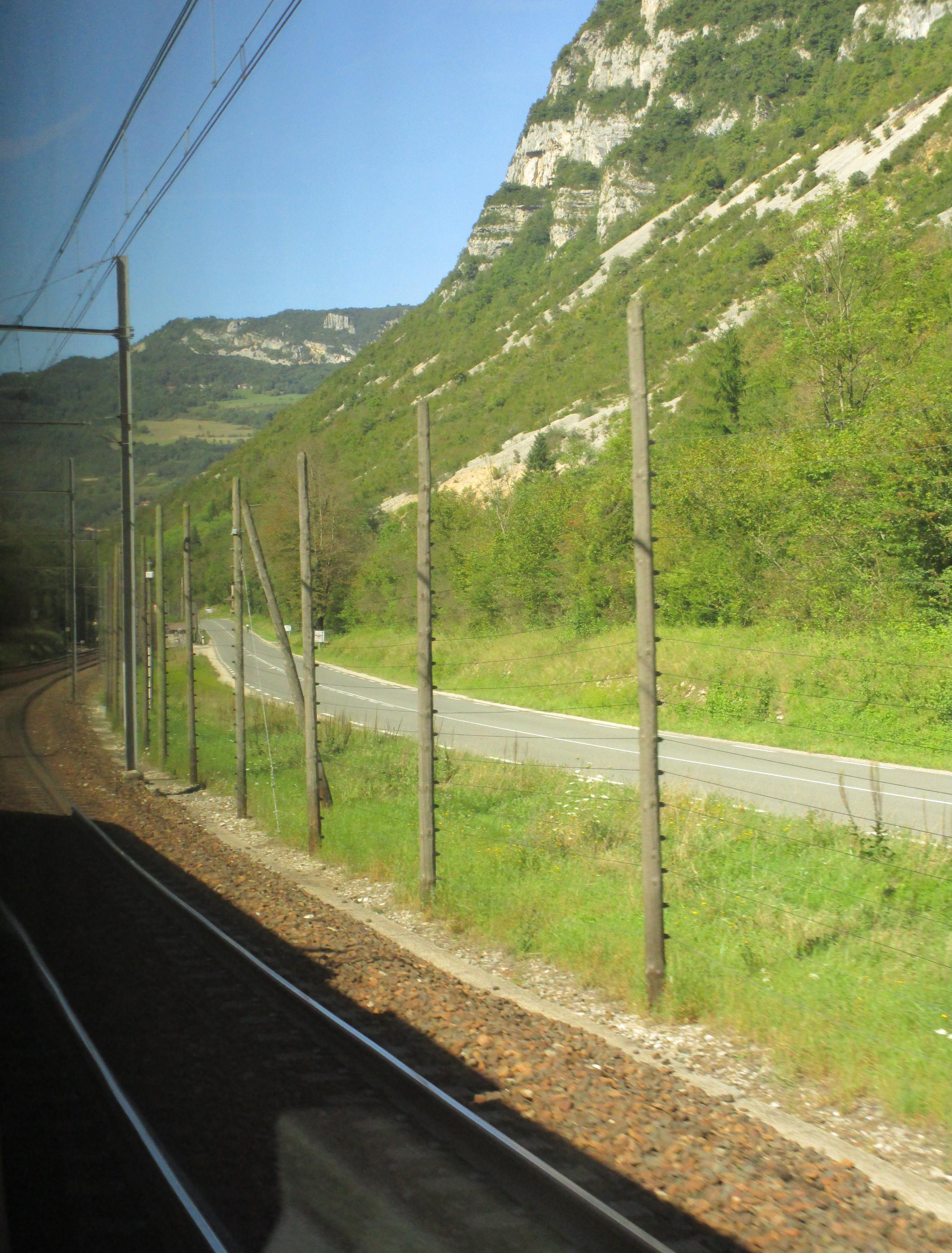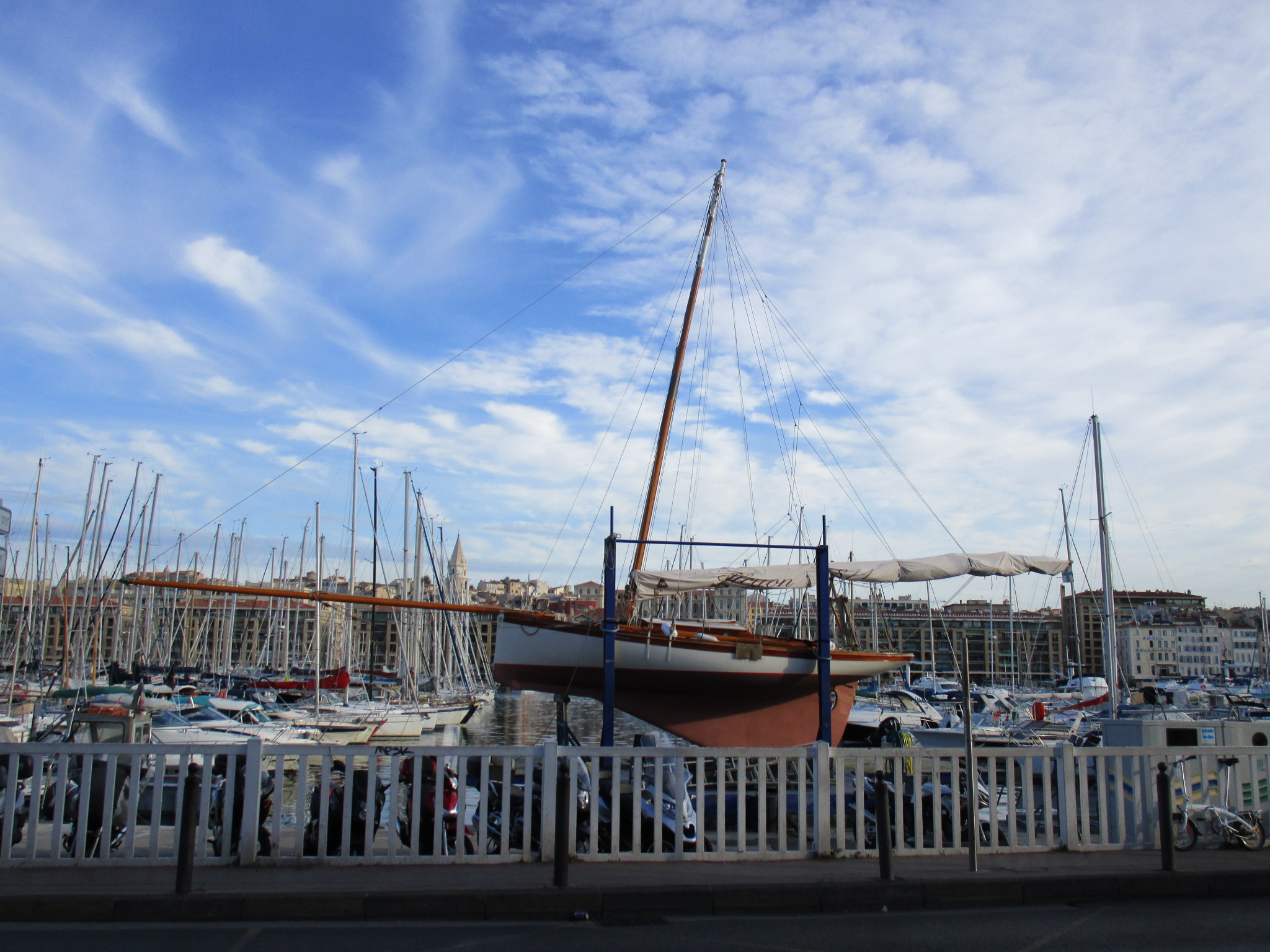 Second day of sailing! I rose at dawn and cleaned up in the marina shower. Going into this trip, one of the unknowns for me was whether we’d be on the water around the clock, never showering, or stoppin at marinas occasionally, or what. I had no idea what I was in for, and was prepared to a slimy, smelly sailor for the full week. As it turned out, every night we’d sail into the marina of the nearest coastal town and dock the ship. All of these marinas have pay showers, so we stayed relatively clean. I say “relatively”, because after only a few hours in the sunshine on the open water, you are pretty nasty. The metamorphosis before and after shower was pretty remarkable, and lord knows I do love a long hot shower (ask my family, I’m notorious for it).
Second day of sailing! I rose at dawn and cleaned up in the marina shower. Going into this trip, one of the unknowns for me was whether we’d be on the water around the clock, never showering, or stoppin at marinas occasionally, or what. I had no idea what I was in for, and was prepared to a slimy, smelly sailor for the full week. As it turned out, every night we’d sail into the marina of the nearest coastal town and dock the ship. All of these marinas have pay showers, so we stayed relatively clean. I say “relatively”, because after only a few hours in the sunshine on the open water, you are pretty nasty. The metamorphosis before and after shower was pretty remarkable, and lord knows I do love a long hot shower (ask my family, I’m notorious for it).
 After shower, while Andreas et al were getting ready for departure, I hoofed down the marina to get a picture of this exotic old sailboat that was undergoing a restoration. All along the marina were these boats being worked on by contractors, and this one was obvious historic and a labor of love for someone. I’m sure the comically long boom off the front identifies the type of sailboat, but I don’t know what it is.
After shower, while Andreas et al were getting ready for departure, I hoofed down the marina to get a picture of this exotic old sailboat that was undergoing a restoration. All along the marina were these boats being worked on by contractors, and this one was obvious historic and a labor of love for someone. I’m sure the comically long boom off the front identifies the type of sailboat, but I don’t know what it is.
After preparing the boat for departure, Andreas once again ceded the captain’s chair to Andy and enjoyed the view with me up front as we slowly eased out of the Marseille harbor. The castle on the right is Fort Saint-Jean, a 17th-century fort built by Louis XIV to protect the governor from the local people — the cannons were aimed not out towards the sea, but in towards town!
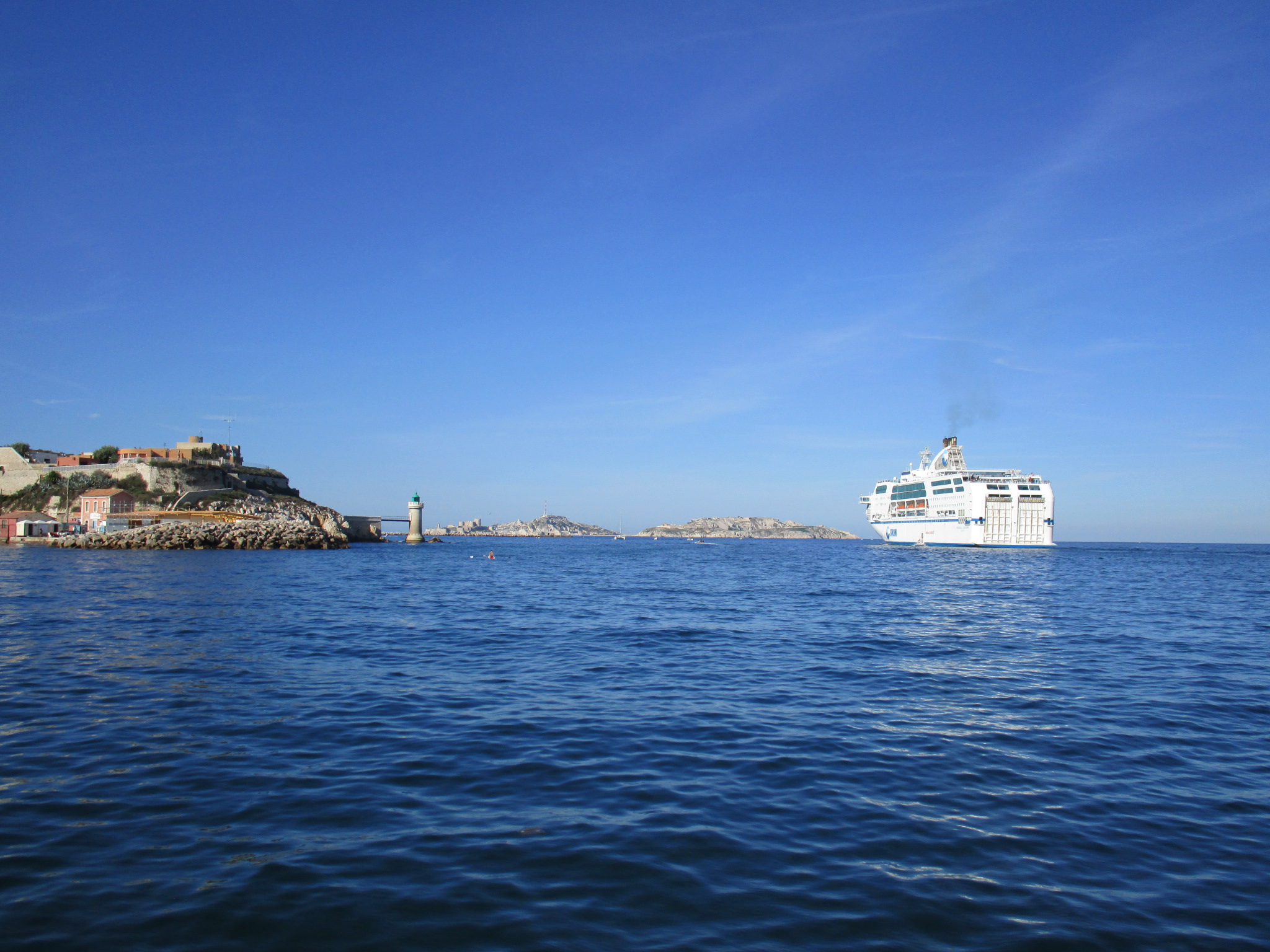 As we headed into the open water, we started to encounter more serious traffic. Marseille is the main ferry transit point for this part of the Mediterranean, and there is constant activity with both small pleasure boats going in and out of the old city harbor and huge commercial crafts accessing the big industrial harbor. Many of these big ships are ferry boats heading to Sardinia and Algiers, carrying both tourist traffic and regular commercial traffic. You do not want to be surprised to see one of these bearing down on your tiny little sailboat.
As we headed into the open water, we started to encounter more serious traffic. Marseille is the main ferry transit point for this part of the Mediterranean, and there is constant activity with both small pleasure boats going in and out of the old city harbor and huge commercial crafts accessing the big industrial harbor. Many of these big ships are ferry boats heading to Sardinia and Algiers, carrying both tourist traffic and regular commercial traffic. You do not want to be surprised to see one of these bearing down on your tiny little sailboat.
Once we cleared the harbor traffic, we put the boat onto autopilot (still on gas engines) and settled down for a nice late breakfast. German breakfasts are serious undertakings, with breads, meats, cheeses, juices, all sort of wonderful things. I devoured it all.
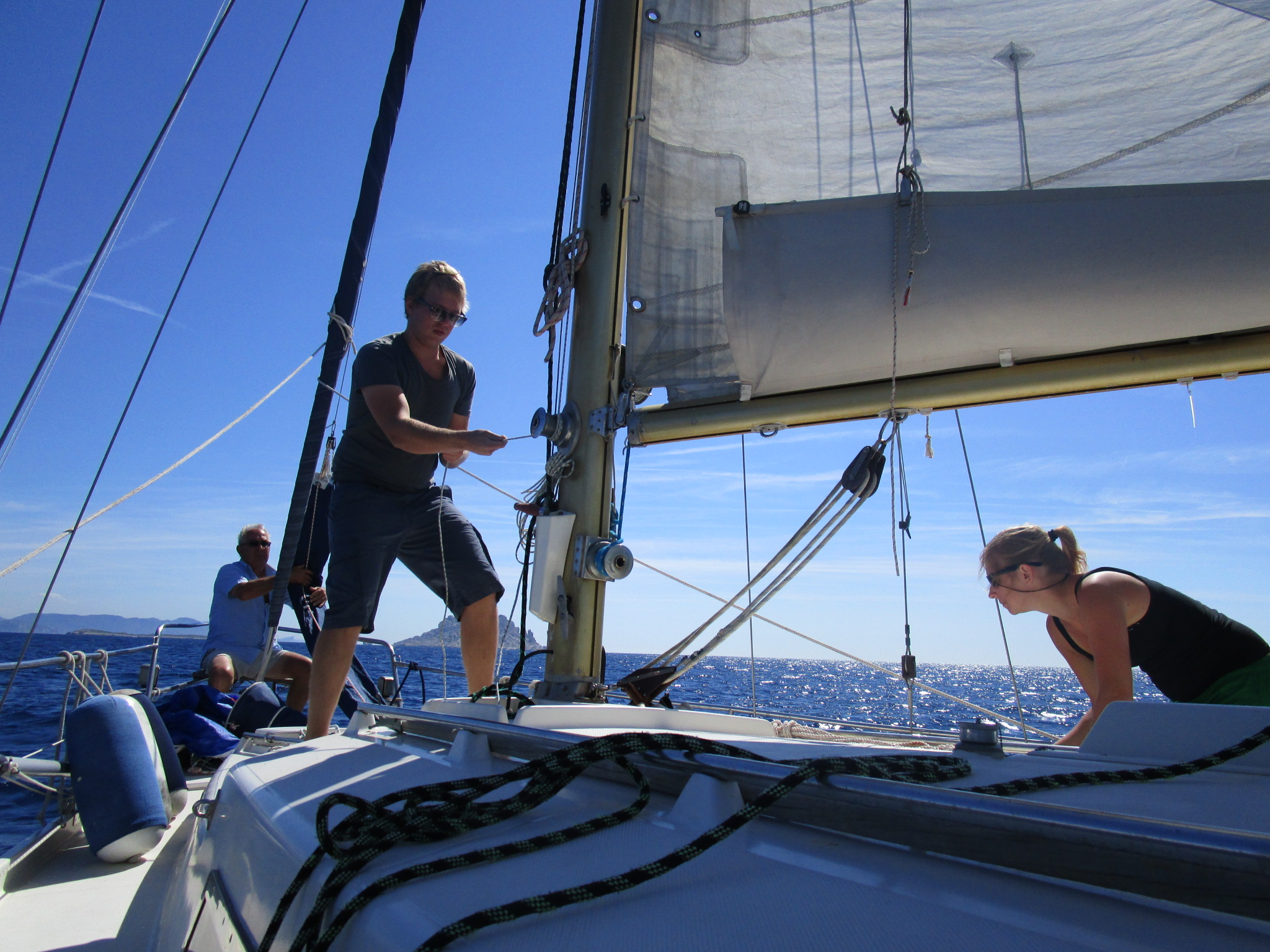 Finally, some sailing! Andreas, Andy and Nora got to unfurling the sails — I’d be helpful whereever I could, and whenever so ordered, but otherwise I stayed out of the way and watched them work. This type of sailboat (a ketch) has three sails, the big one in the middle of the boat called the mainsail, one at the front (bow) called a jib, and one at the back (stern) called a mizzen.
Finally, some sailing! Andreas, Andy and Nora got to unfurling the sails — I’d be helpful whereever I could, and whenever so ordered, but otherwise I stayed out of the way and watched them work. This type of sailboat (a ketch) has three sails, the big one in the middle of the boat called the mainsail, one at the front (bow) called a jib, and one at the back (stern) called a mizzen. 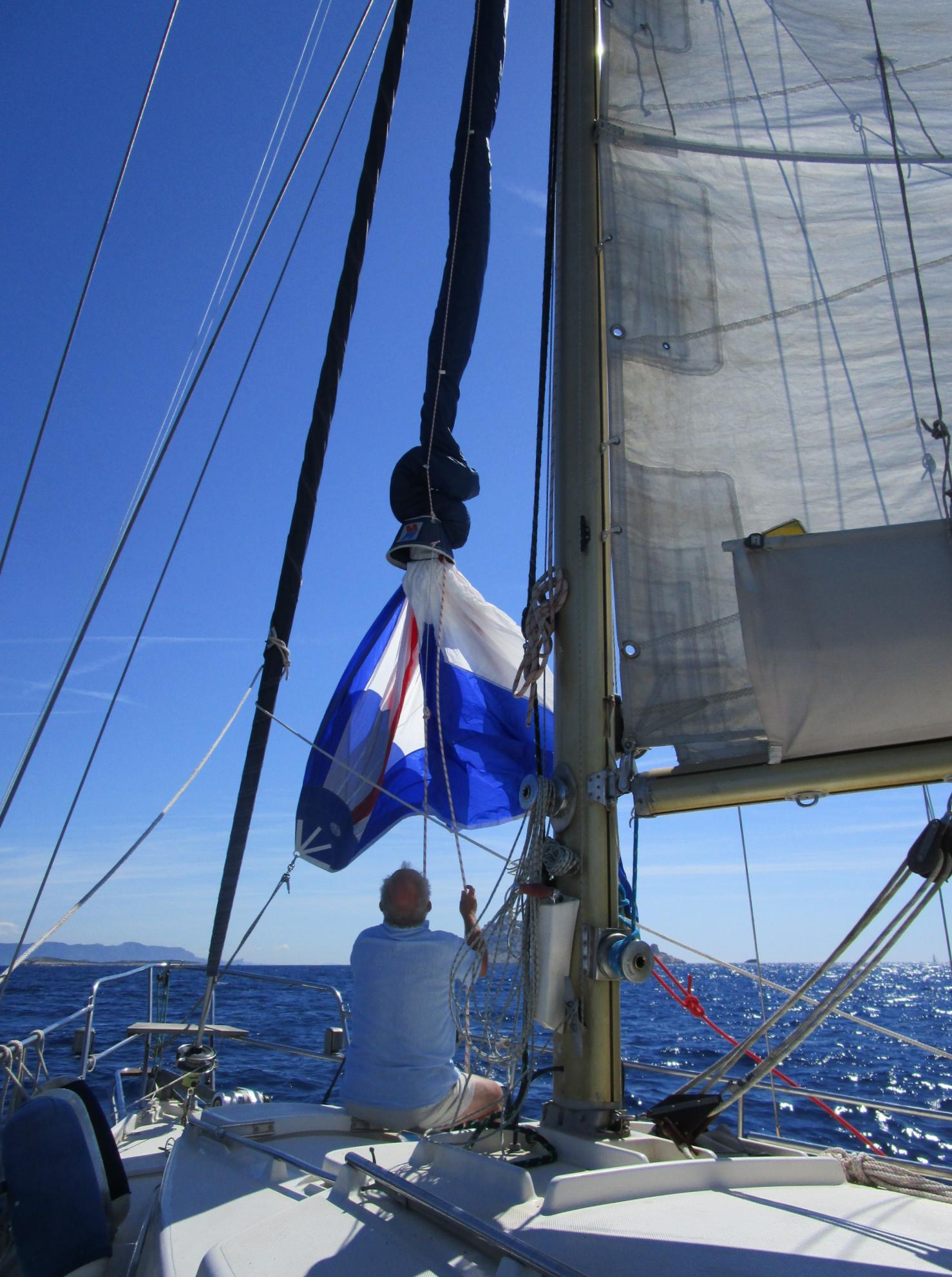 So when setting sail, you’ve got three different sails and booms to deal with, and so enough to keep three people very busy for a couple minutes. But the ropes (“sheets”) that raise and control those sails all come back to the cockpit, so in theory at least ONE person could do the whole thing. Not likely though.
So when setting sail, you’ve got three different sails and booms to deal with, and so enough to keep three people very busy for a couple minutes. But the ropes (“sheets”) that raise and control those sails all come back to the cockpit, so in theory at least ONE person could do the whole thing. Not likely though.
 We had great wind, at our backs actually, and in that case you can bust out the king of the sails, the spinnaker. Instead of the smaller, triangular jib sail that is designed to work with crosswinds, the spinnaker simply blows up to huge size and grabs all of the wind to pull you straight ahead. In the photo at right you can see how the sail is kept furled inside a tube, and unfurled by pulling the tube up (via ropes and pullies, naturally) to release the sail inside. At left you see it fully unfurled for the first time — note the sailboat in the distance that is also running its spinnaker. Actually, our sail was a modified form of spinnaker called a gennaker, sort of a hybrid between a genoa sail and a spinnaker sail.
We had great wind, at our backs actually, and in that case you can bust out the king of the sails, the spinnaker. Instead of the smaller, triangular jib sail that is designed to work with crosswinds, the spinnaker simply blows up to huge size and grabs all of the wind to pull you straight ahead. In the photo at right you can see how the sail is kept furled inside a tube, and unfurled by pulling the tube up (via ropes and pullies, naturally) to release the sail inside. At left you see it fully unfurled for the first time — note the sailboat in the distance that is also running its spinnaker. Actually, our sail was a modified form of spinnaker called a gennaker, sort of a hybrid between a genoa sail and a spinnaker sail. 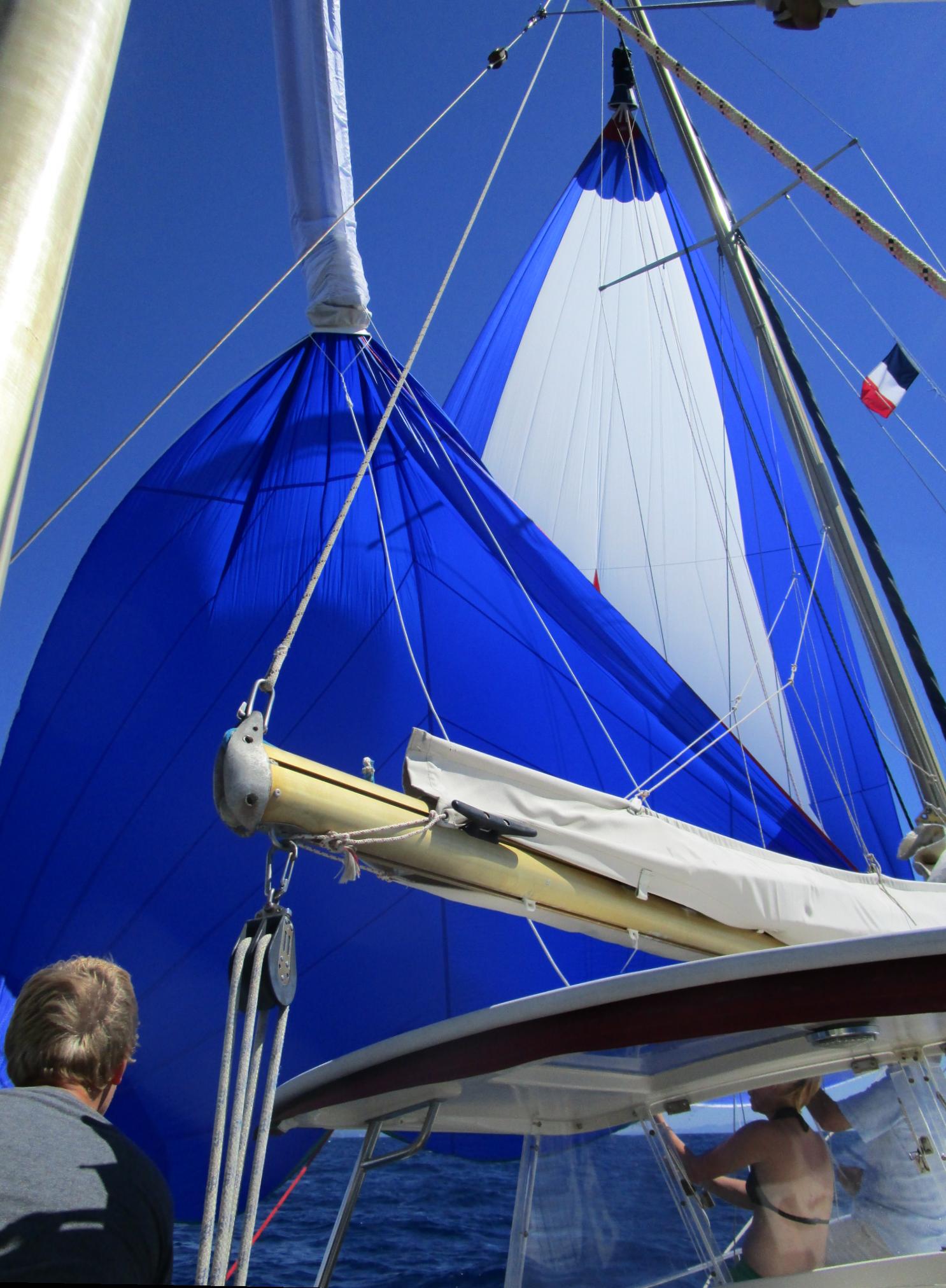 Instead of both bottom corners flying free, held back only by ropes, in the gennaker one corner is held to the bow of the ship and the other corner is flying free. This way it’s off to one side of the boat, and actually catching slightly more wind than a spinnaker would, because you then sail with the wind slightly off your rear — the mainsail (in the middle of the boat) doesn’t “shadow” the gennaker and you get more total wind power driving the boat.
Instead of both bottom corners flying free, held back only by ropes, in the gennaker one corner is held to the bow of the ship and the other corner is flying free. This way it’s off to one side of the boat, and actually catching slightly more wind than a spinnaker would, because you then sail with the wind slightly off your rear — the mainsail (in the middle of the boat) doesn’t “shadow” the gennaker and you get more total wind power driving the boat.
But wait, there’s more! One gennaker wasn’t enough, Andreas had to bring out two! Heck, we had them on board, might as well use them. In the photo to the right, you can see the mainsail (in the middle of the boat) brought down and bagged on top of the main boom, the fore/jib gennaker flying at the front of the boatd upper right of picture) and finally the second gennaker being let out by Andreas (in the extreme lower right corner of the picture, behind Nora).
All of these different sails and sail configurations are designed to extract as much power out of the wind and get you moving as fast as you can in the direction that you want to go. In this case, with all these sails running, we were pushing 12 knots, which I will tell you now is SERIOUSLY HAULING ASS. We were really flying, pounding through the waves at what seemed like breakneck speed.


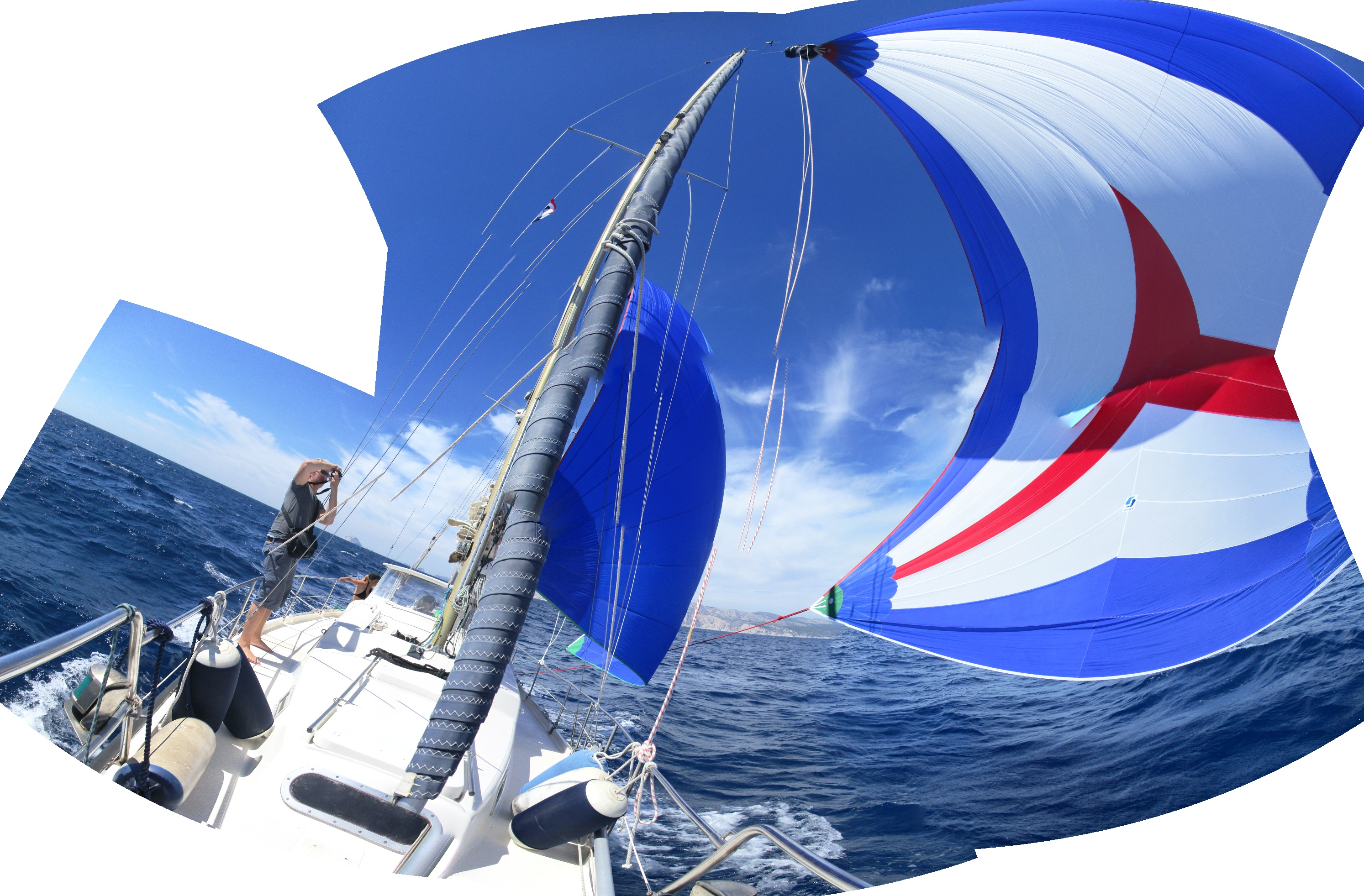
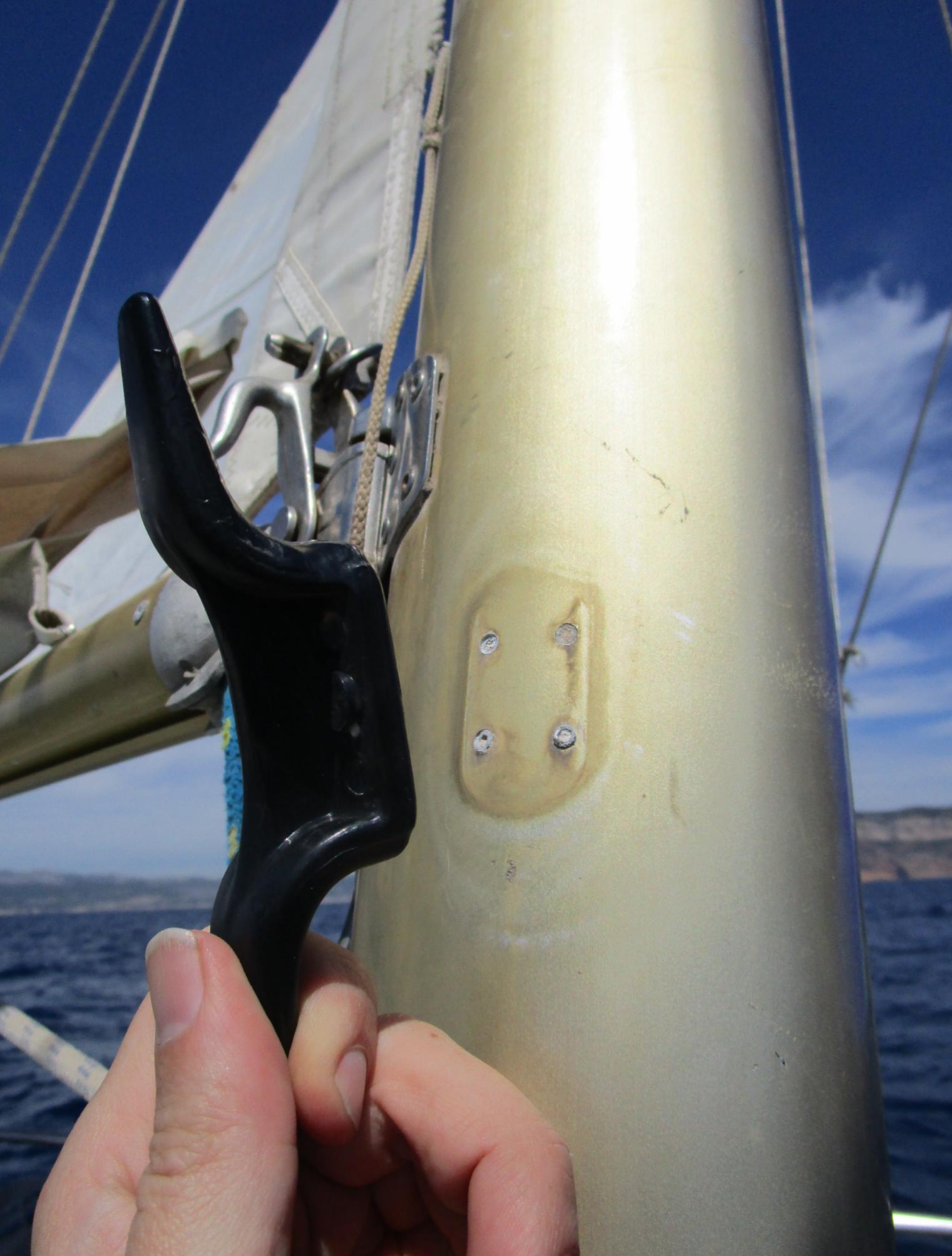 After about an hour of fast running with the sails set like this, suddenly we had to spring into action. One of the cleats had popped off the main mast and a sail went flying. Andreas said that it was not one of the original cleats, rather one that a local worker had added for him. Poor quality work, but we also had too much rope tied off on that one little cleat — there are bigger cleats designed to handle bigger loads. Anyway, that’s actually really dangerous, and certainly things got real exciting for a minute there.
After about an hour of fast running with the sails set like this, suddenly we had to spring into action. One of the cleats had popped off the main mast and a sail went flying. Andreas said that it was not one of the original cleats, rather one that a local worker had added for him. Poor quality work, but we also had too much rope tied off on that one little cleat — there are bigger cleats designed to handle bigger loads. Anyway, that’s actually really dangerous, and certainly things got real exciting for a minute there.
At some point, not long into this serious sailing, I started to realize that I didn’t feel so good. Uh oh. I settled into a corner and tried to keep my eyes up and on the horizon, but it wasn’t helping. That great big breakfast was coming back. I quietly signaled to Nora that I was about to become a, uh, unuseful crew member, took up a post on the side of the boat away from everyone, and … yeah, I got seasick.
Nora dug up some anti-nausea medication for me. It felt like a sleeping pill (which I hate) but it did the job. Along with generally taking it easy for the rest of the day, I didn’t get sick again. In future days, as long as I went easy on the breakfast (especially not loading up on orange juice, duh), I felt fine. I guess it just takes the body a couple days to adapt. Hey, I’m just like a good percentage of NASA astronauts!
 Here’s a good view of the cockpit, the main seating area (I actually forget now what the right term is for it). It’s where the captain mans the controls, and where all the ropes end up. Close to us in this view is the red rope going around the port winch, a one-way ratcheting device that helps to pull the rope in and keep it tight. In this dual-gennaker configuration, Andreas decided to run the other rope (the green one) across the cabin — that’s not normal, but what we improvised that day. Then at the rear of the cabin (to the right in this picture) you see the main mast with quite a few ropes cleated off there.
Here’s a good view of the cockpit, the main seating area (I actually forget now what the right term is for it). It’s where the captain mans the controls, and where all the ropes end up. Close to us in this view is the red rope going around the port winch, a one-way ratcheting device that helps to pull the rope in and keep it tight. In this dual-gennaker configuration, Andreas decided to run the other rope (the green one) across the cabin — that’s not normal, but what we improvised that day. Then at the rear of the cabin (to the right in this picture) you see the main mast with quite a few ropes cleated off there.
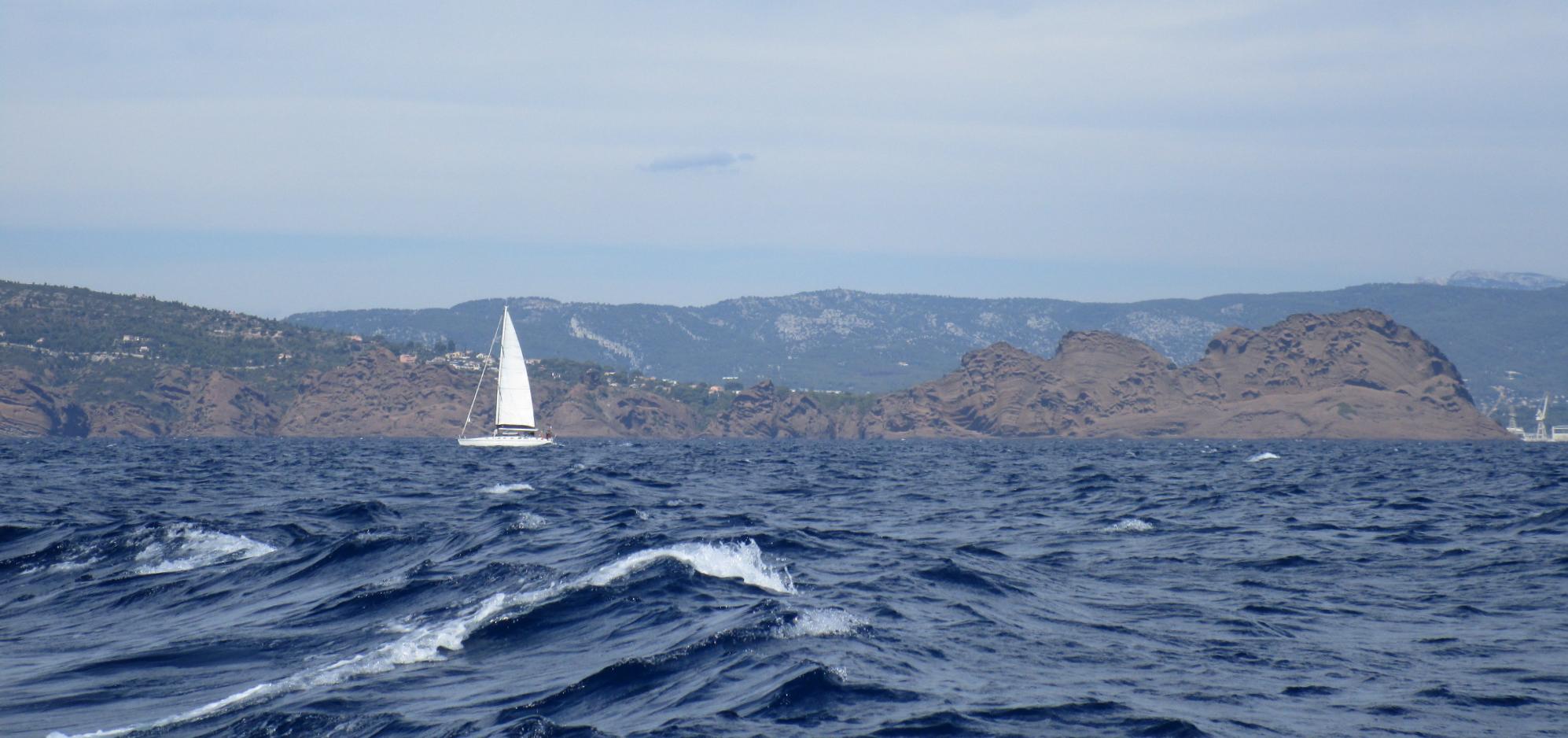
We made our way along the French coast, east of Marseille, passing starkly beautiful geological formations along the way.
Our destination for the evening would be the town of Porquerolles, on the island of Iles d’Hyeres. We got in pretty late, and as I recall, Andreas had to sweet-talk someone into getting a berth — I think we got the private berth of someone who was out of town (with their boat).
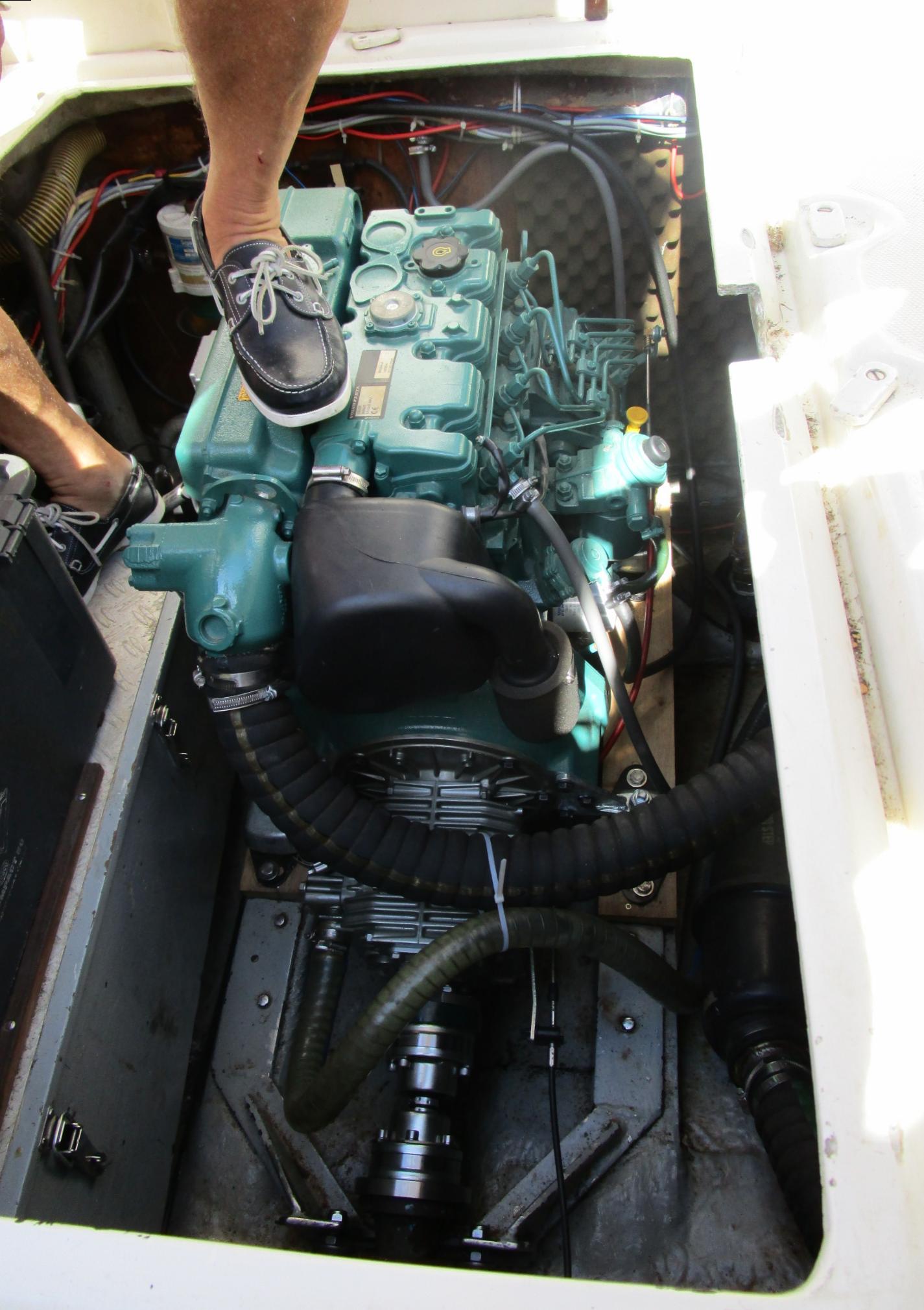 Now finally Andreas would get a look at the transmission. As I wrote earlier, this was a brand new engine, mated to the old transmission. I had already heard about how matching those up had caused some drama in the past year as they were doing the engine upgrade. But while we had been on the water today, in particular while maneuvering in close quarters in the harbors, Andreas became concerned about strange sounds that were coming from the transmission when the thing was put into reverse. So we popped the lid off the engine compartment, Andreas got down in there to take a look, and generally grumbled about the situation.
Now finally Andreas would get a look at the transmission. As I wrote earlier, this was a brand new engine, mated to the old transmission. I had already heard about how matching those up had caused some drama in the past year as they were doing the engine upgrade. But while we had been on the water today, in particular while maneuvering in close quarters in the harbors, Andreas became concerned about strange sounds that were coming from the transmission when the thing was put into reverse. So we popped the lid off the engine compartment, Andreas got down in there to take a look, and generally grumbled about the situation.
We washed up and headed to dinner at a little restaurant in the town that was recommended by my cousin (and Andreas’ daughter) Cornelia. But we were all quite exhausted, me especially due to my bout of seasickness, and honestly we just wanted to get through dinner and to sleep. But after dinner we did wander round a bit. This town has a central square surrounded by little shops including groceries, so we were able to load up on perishables and the occasional toiletry. I believe I added once again to my growing collection of suntan lotion bottles. Walked around, watched a bocce game (actually here it’s called boule or petanque), and headed back to the sailboat and finally some rest.
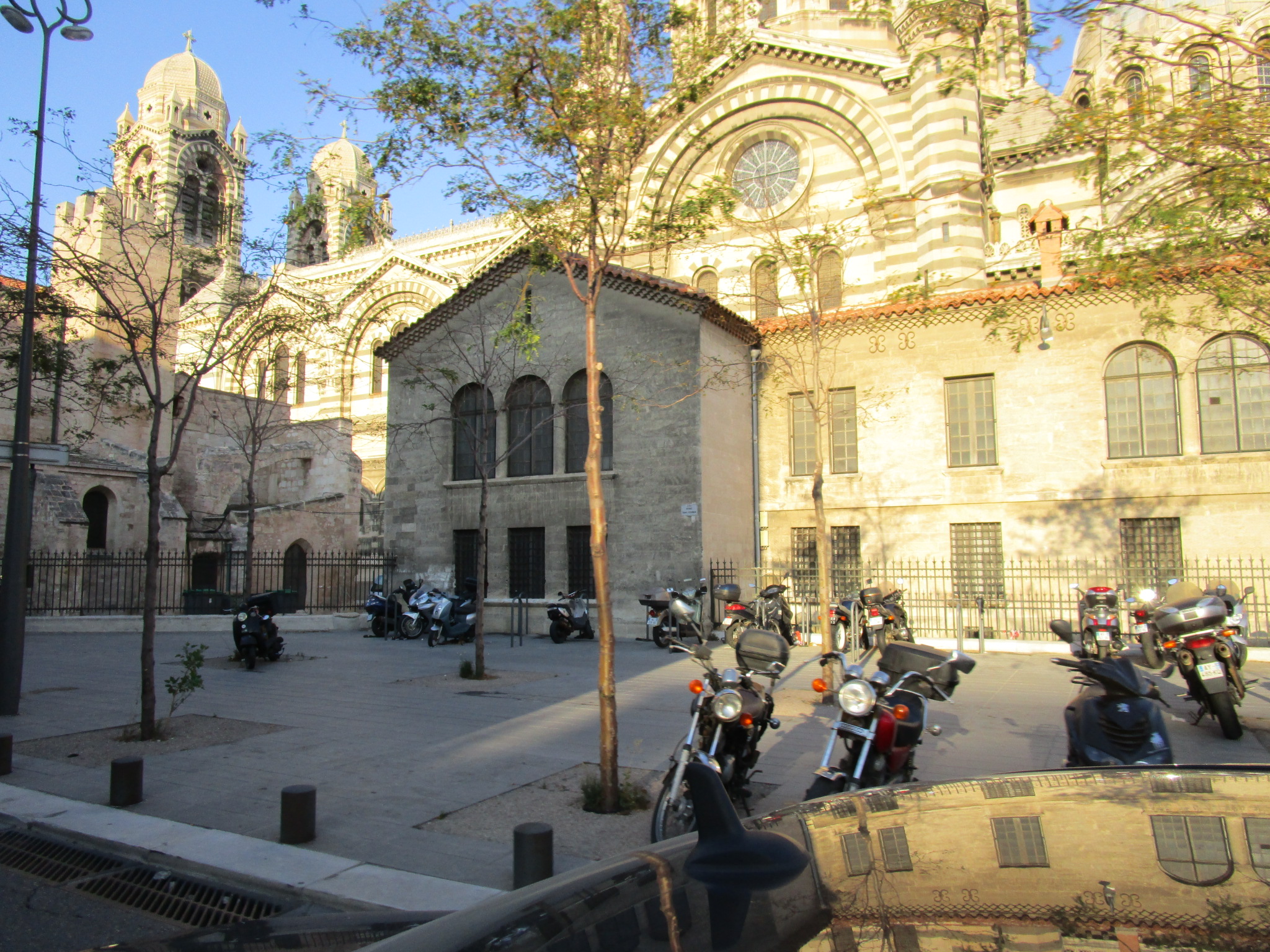 On the way to the train station, Andreas had the taxi take a circuituitous route that passed a few landmarks, including the Catholic cathedral we saw from the water. But this was literally a 5 minute tour of the city, and I was just firing the camera out the window as we sped by.
On the way to the train station, Andreas had the taxi take a circuituitous route that passed a few landmarks, including the Catholic cathedral we saw from the water. But this was literally a 5 minute tour of the city, and I was just firing the camera out the window as we sped by. At 9am, I boarded the TGV train and headed for Paris.
At 9am, I boarded the TGV train and headed for Paris. We departed Porquerolles, and promptly got a chance at some more diagonal sailing. Here’s an action shot, screenshotted from Wolfgang’s video for the day. We’re about to execute a turn, from having the wind coming at us from the right / starboard, to having the wind coming at us from the left / port. Nora is at far left, ready to crank the winch that will tighten up the main sail, and I’m collecting the thick rope (“sheet”) coming off that winch and keeping it taughtly wound on the winch so that the winch will grab it. Andreas’s striped shirt is barely visible at lower right, as he is going to pull over the mainsail anchor, along a rail out of view below the video frame. Finally, Andi is at the helm, having just called the turn (“Wende”, the German word for “change”). At this instant, I’m watching the bow waiting for when it starts veering right across the horizon, into the wind and then through the turn to put the wind on the other side of the boat.
We departed Porquerolles, and promptly got a chance at some more diagonal sailing. Here’s an action shot, screenshotted from Wolfgang’s video for the day. We’re about to execute a turn, from having the wind coming at us from the right / starboard, to having the wind coming at us from the left / port. Nora is at far left, ready to crank the winch that will tighten up the main sail, and I’m collecting the thick rope (“sheet”) coming off that winch and keeping it taughtly wound on the winch so that the winch will grab it. Andreas’s striped shirt is barely visible at lower right, as he is going to pull over the mainsail anchor, along a rail out of view below the video frame. Finally, Andi is at the helm, having just called the turn (“Wende”, the German word for “change”). At this instant, I’m watching the bow waiting for when it starts veering right across the horizon, into the wind and then through the turn to put the wind on the other side of the boat.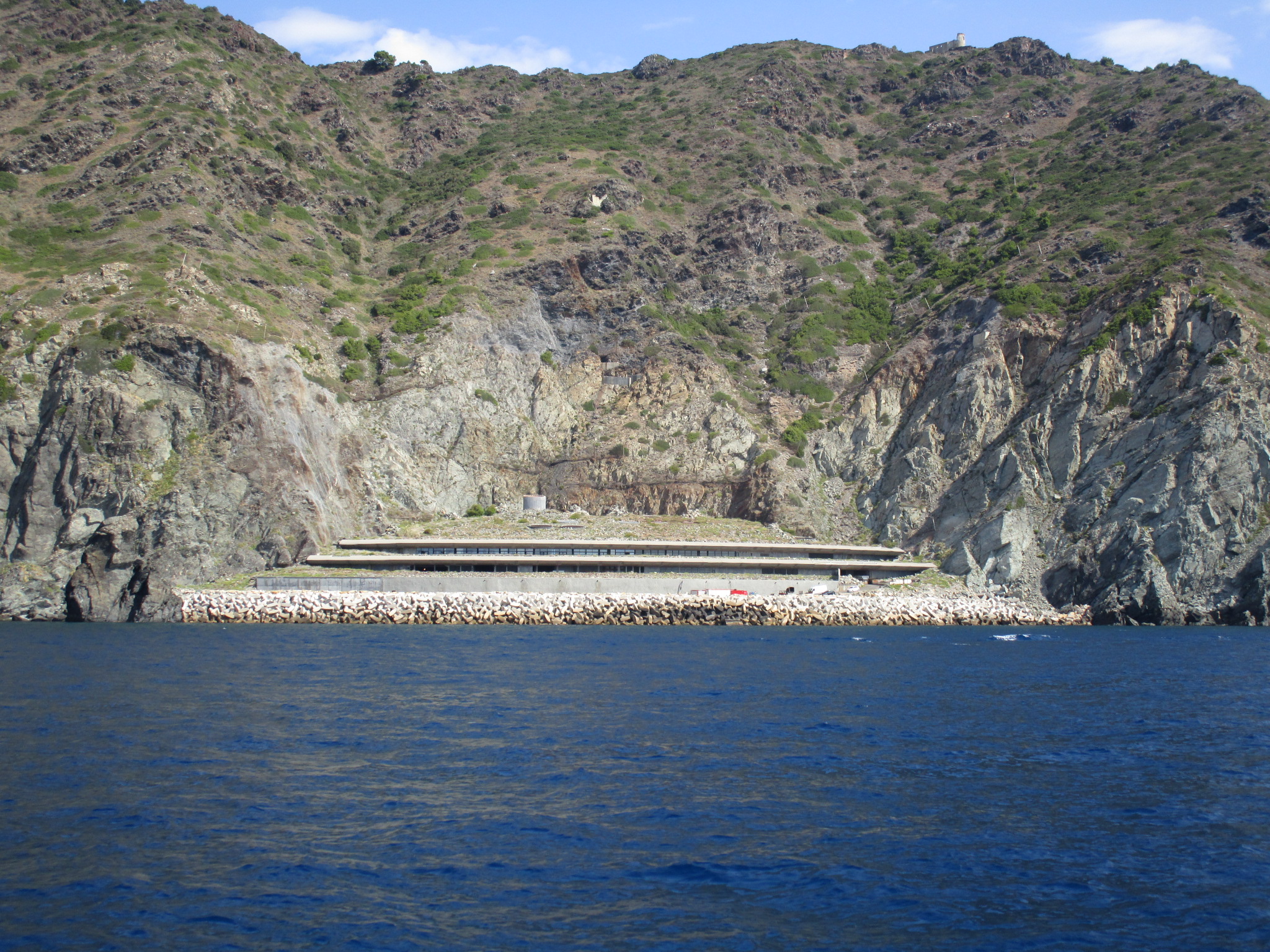 We sailed by a freaky … military base? Billionarie’s lair? CIA hideout? Who knows.
We sailed by a freaky … military base? Billionarie’s lair? CIA hideout? Who knows. Andreas napping in his favorite spot.
Andreas napping in his favorite spot.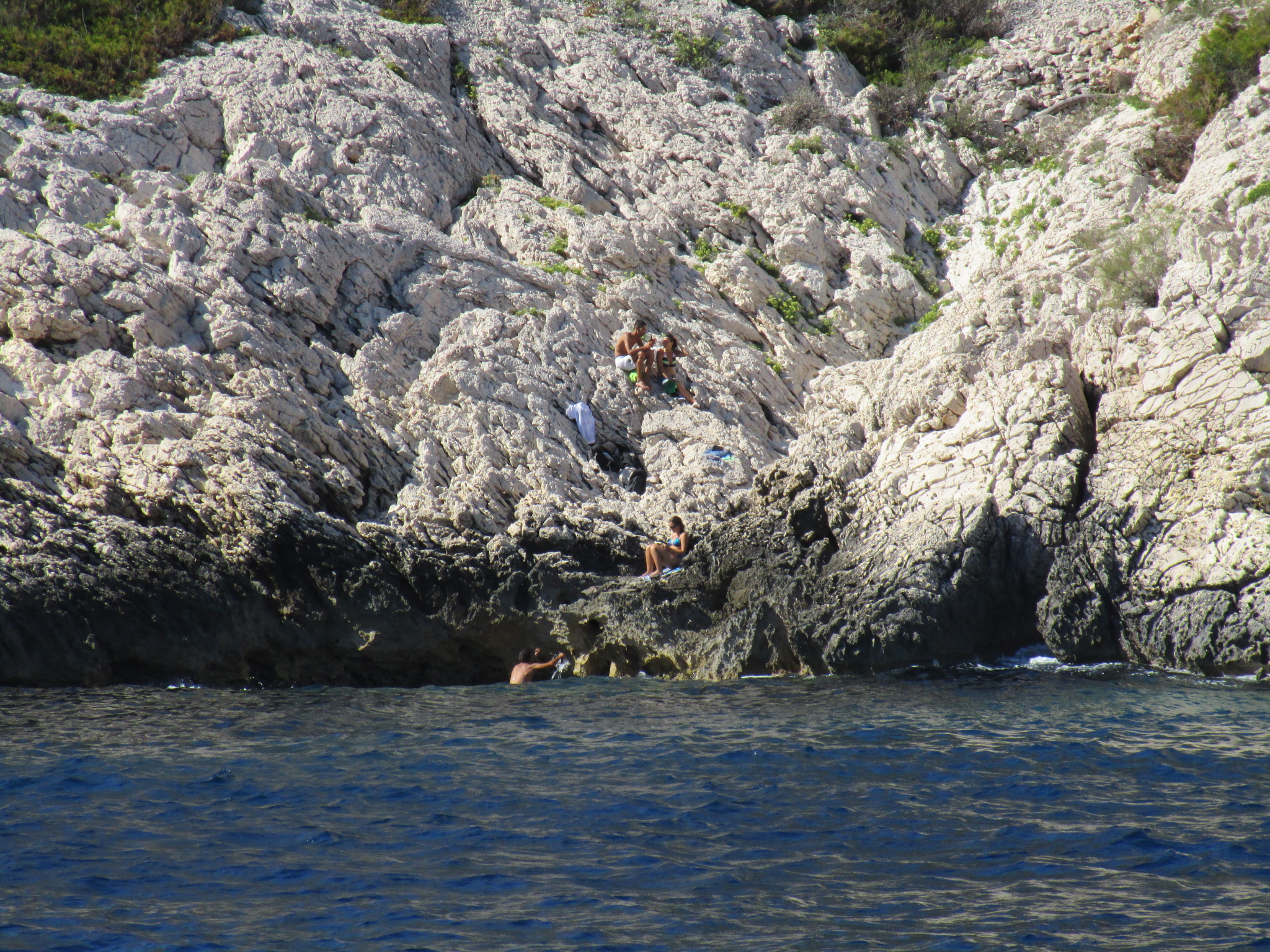 We sailed into a little cove. People were hiking in the hills, jumping from outcrops into the water, generally enjoying the day. A small ferry passed by with tourists gawking at us eating lunch. It was probably a lot easier to get to the tiny town at the end of the cove by sea than by land.
We sailed into a little cove. People were hiking in the hills, jumping from outcrops into the water, generally enjoying the day. A small ferry passed by with tourists gawking at us eating lunch. It was probably a lot easier to get to the tiny town at the end of the cove by sea than by land. We passed the bare white cliffs of the
We passed the bare white cliffs of the 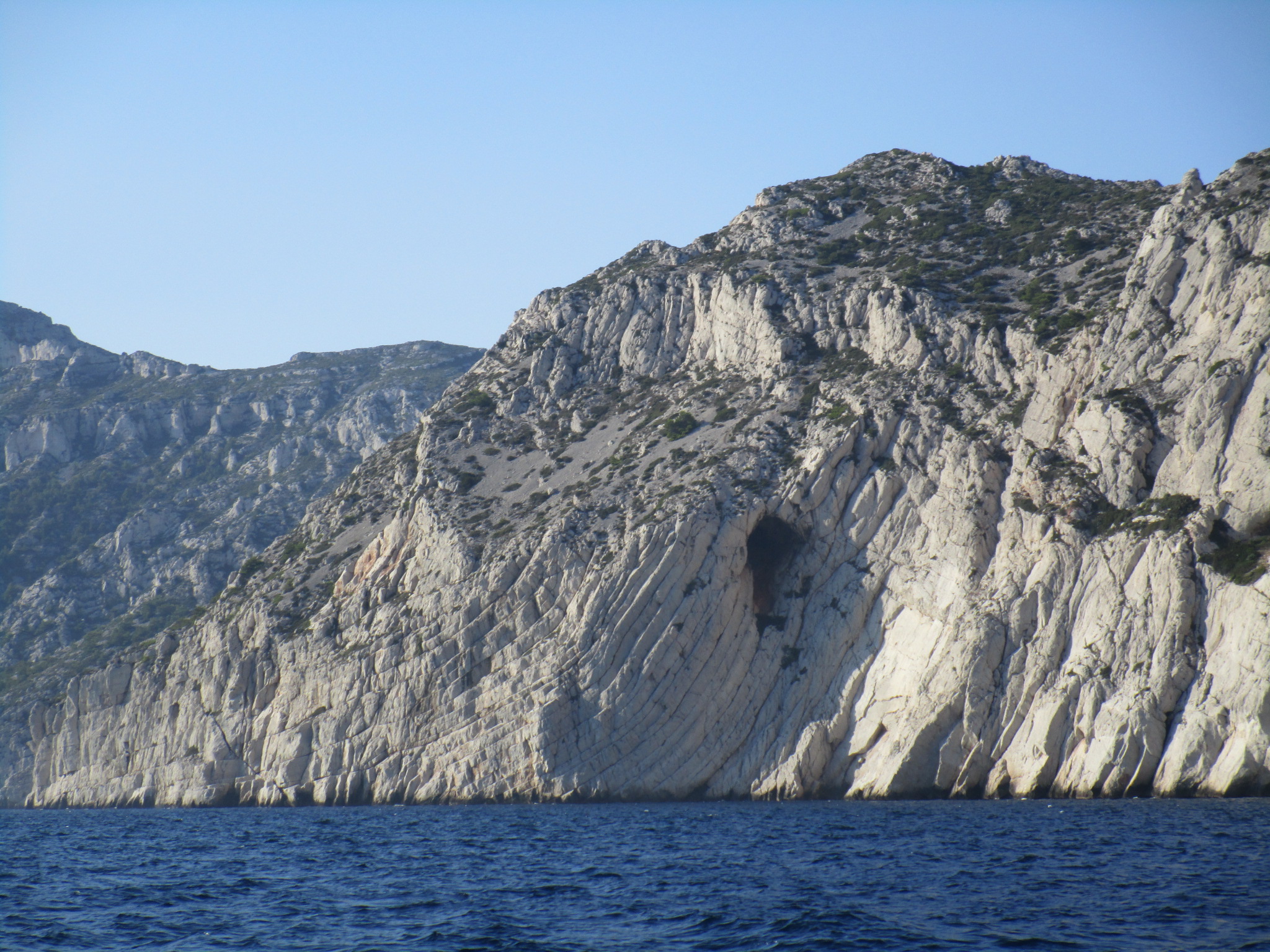 after mile of incredible coastline.
after mile of incredible coastline.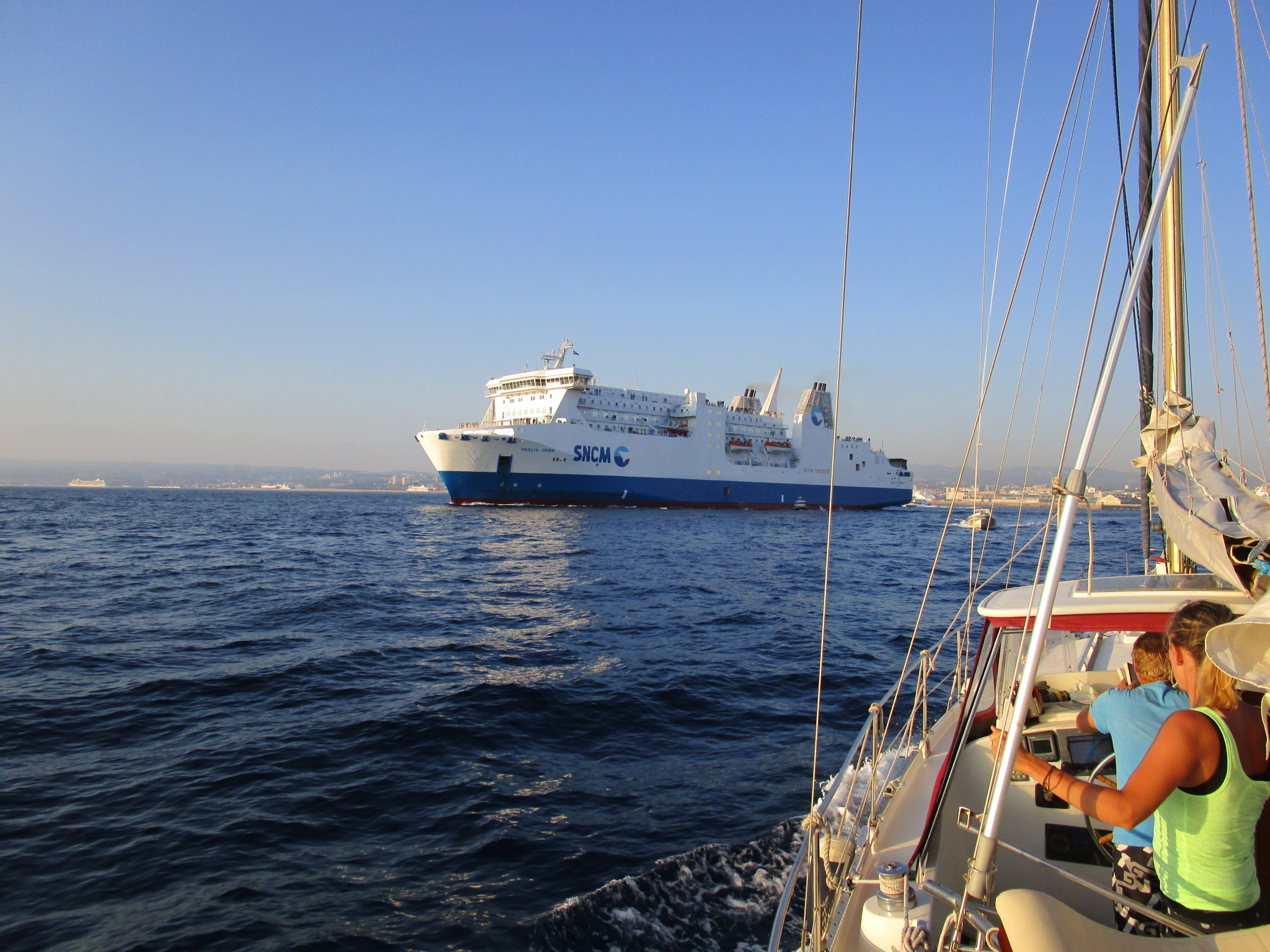 As we approached the port of Marseilles, we dropped our sails and proceeded under engine power, to preserve full maneuverability. There were huge ships passing nearby and you don’t mess with them or you get flattened. In fact, in this shot you see a harbor pilot boat heading straight for us to make sure we know damn well which way to go.
As we approached the port of Marseilles, we dropped our sails and proceeded under engine power, to preserve full maneuverability. There were huge ships passing nearby and you don’t mess with them or you get flattened. In fact, in this shot you see a harbor pilot boat heading straight for us to make sure we know damn well which way to go. Another ferry colossus. No sudden movements …
Another ferry colossus. No sudden movements …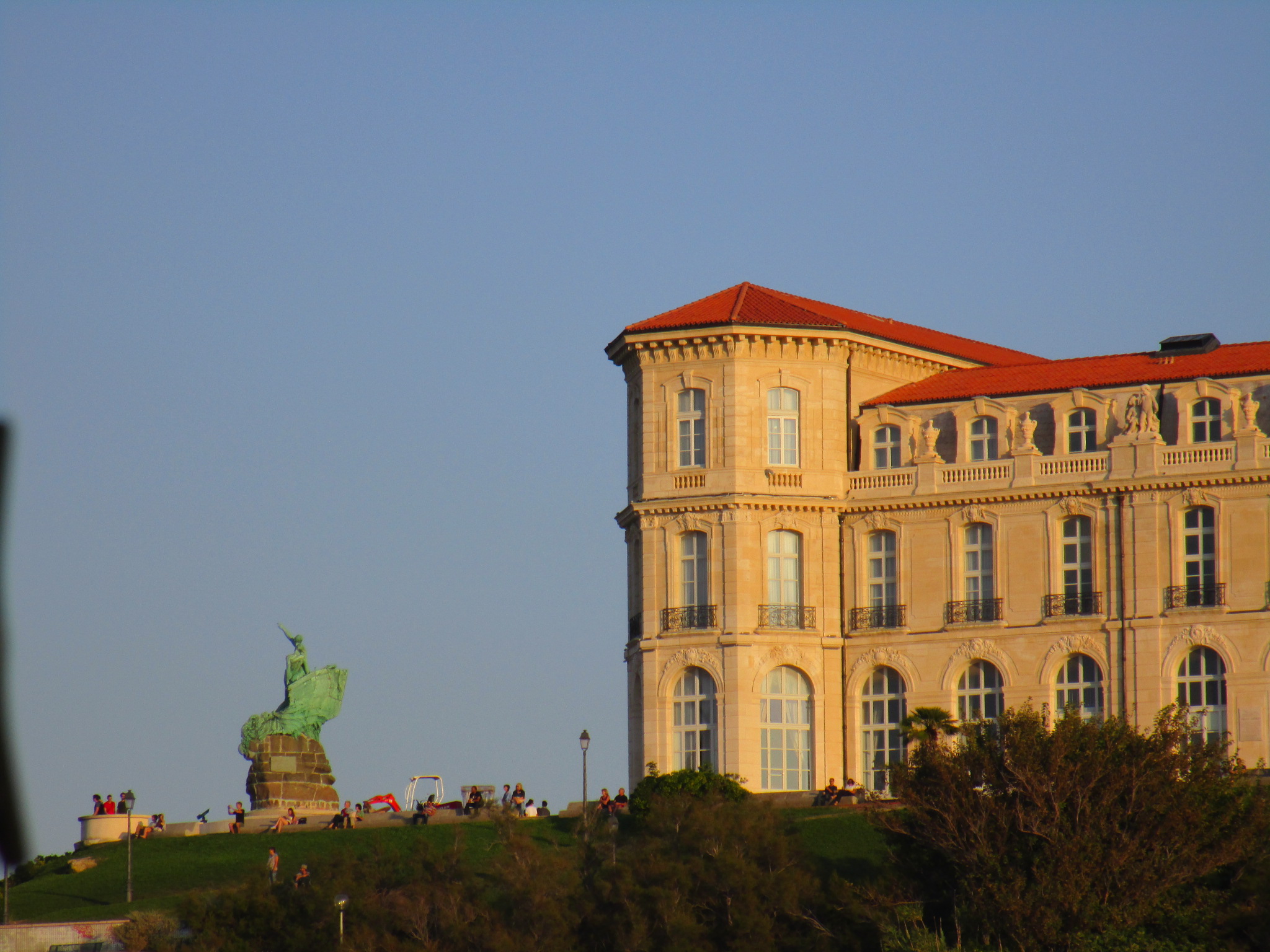 Overlooking the harbor is the Palais du Pharo, built in the 1800s for Napoleon, and in front of that is the Monument to the Heroes and Victims of the Sea.
Overlooking the harbor is the Palais du Pharo, built in the 1800s for Napoleon, and in front of that is the Monument to the Heroes and Victims of the Sea. On the other side of the water looms the
On the other side of the water looms the  Right at the marina entrance, the Fort Saint-Jean. What an amazing, historic city.
Right at the marina entrance, the Fort Saint-Jean. What an amazing, historic city. Just as we approached the marina entrance, we encountered some young men (perhaps the Euro equivalent of frat boys) whose sailboat was stranded with a dead engine. Andreas quickly threw a rope over to them and towed them in, literally dropping them off at a pier as we motored by it.
Just as we approached the marina entrance, we encountered some young men (perhaps the Euro equivalent of frat boys) whose sailboat was stranded with a dead engine. Andreas quickly threw a rope over to them and towed them in, literally dropping them off at a pier as we motored by it. Before we left Saint-Maxime, we ooh’d and aah’d over a neighbor. It was another, much larger sailing vessel (I hesitate to call it a boat) made by the same company (
Before we left Saint-Maxime, we ooh’d and aah’d over a neighbor. It was another, much larger sailing vessel (I hesitate to call it a boat) made by the same company (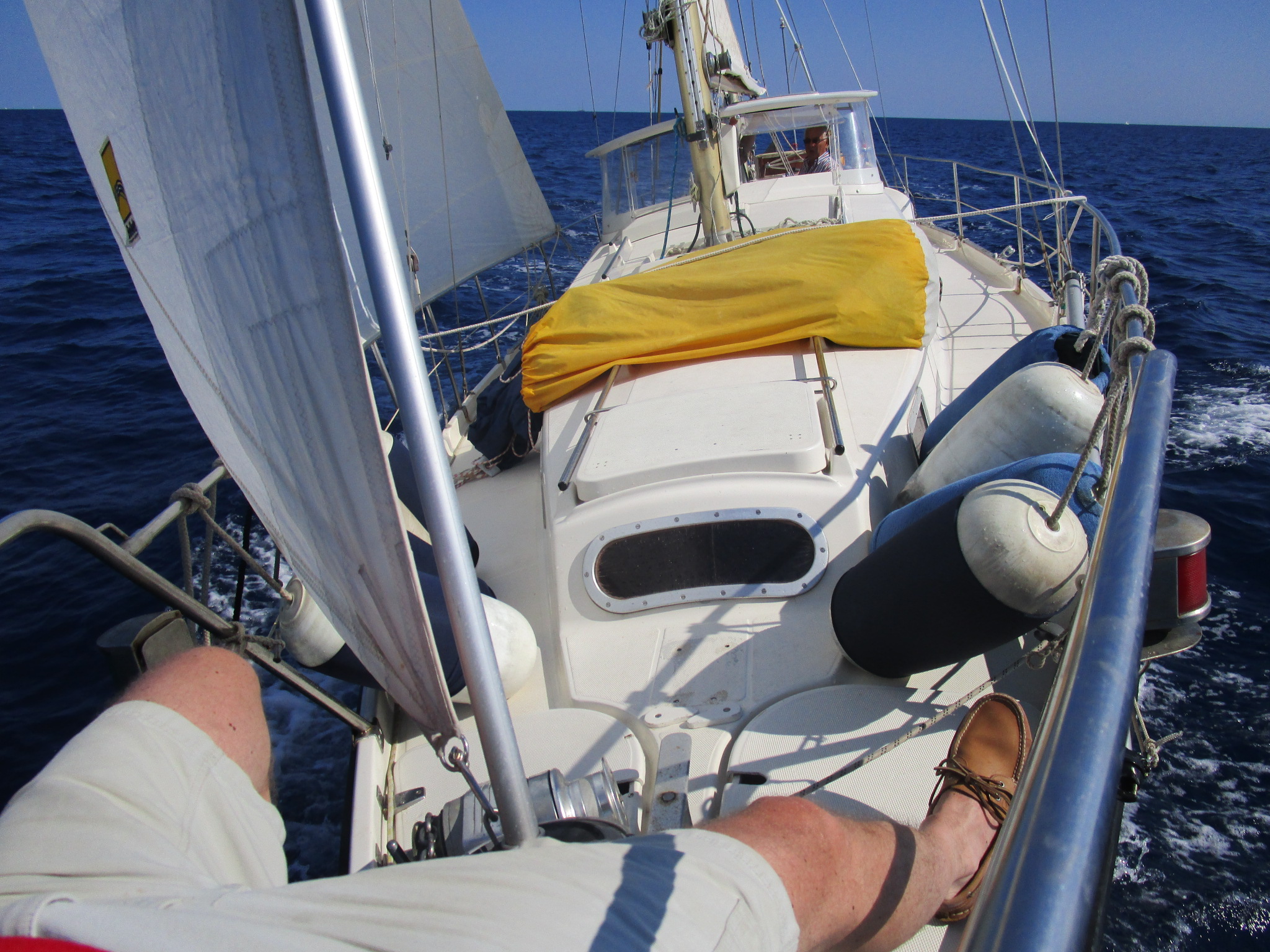 We departed Sainte-Maxime, got out into the open water, and picked up a pretty good wind which had us leaned over pretty hard.
We departed Sainte-Maxime, got out into the open water, and picked up a pretty good wind which had us leaned over pretty hard. The impossibly gorgeous and surely violently dangerous rocks of the Cap des Medes, and the ancient fortress (Batterie basse des Medes) perched atop the hills nearby.
The impossibly gorgeous and surely violently dangerous rocks of the Cap des Medes, and the ancient fortress (Batterie basse des Medes) perched atop the hills nearby.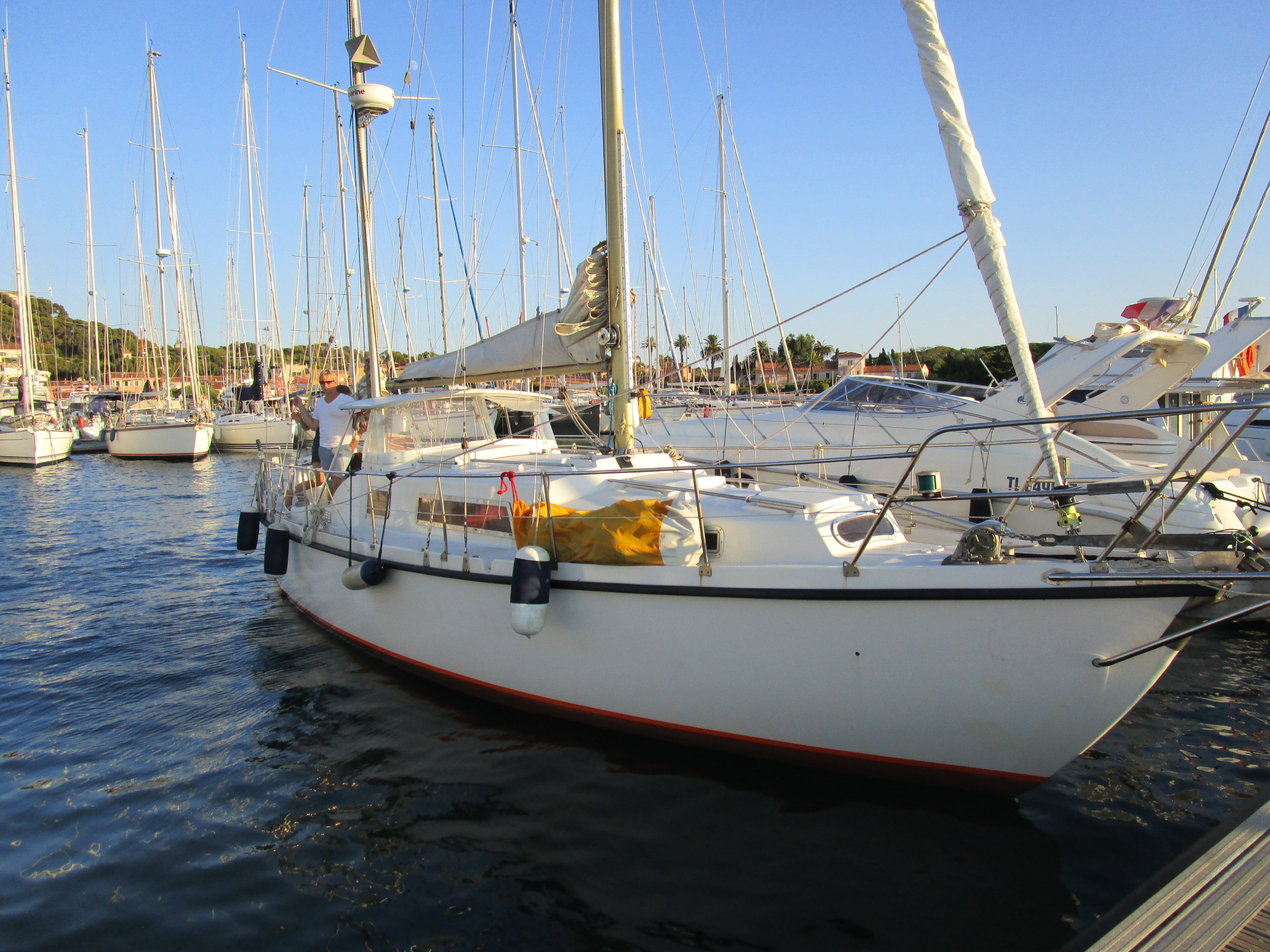 We like Porquerolles so much on the way out that we decided to spend the night there again on the way back.
We like Porquerolles so much on the way out that we decided to spend the night there again on the way back. Steak tartare!
Steak tartare! A great picture of our group, on our second to last night together.
A great picture of our group, on our second to last night together. We left the Bay of Agay and headed for the famed resort city of Saint-Tropez. Here’s a typical view along the way out of Agay.
We left the Bay of Agay and headed for the famed resort city of Saint-Tropez. Here’s a typical view along the way out of Agay. At some point early in the day, we stopped near the shore and got another swim in, another ersatz shower. Andi and Nora jumped into the water from the roof of the boat’s cabin. I was too chickenshit to do that and just refereed the whole enterprise.
At some point early in the day, we stopped near the shore and got another swim in, another ersatz shower. Andi and Nora jumped into the water from the roof of the boat’s cabin. I was too chickenshit to do that and just refereed the whole enterprise. I don’t recall what I was doing here, but clearly I was messing with Nora.
I don’t recall what I was doing here, but clearly I was messing with Nora. Here’s a view of my accommodations for the week, the “room” in the bow. This photo is taken from the doorway looking in, and the very tip of the boat is behind my head. I had all my stuff on the left (including in the two small cabinets) and slept on the right. The big bag at center was my sleeping companion: the huge spinnaker (actually gennaker) sail that was shown in an earlier update here, packed up and ready for deployment next time. Andreas and Wolfgang had the main cabin (the main room inside the boat, holding the kitchen and radio and main table), and Andi and Nora had the rear cabin, only slightly larger than mine.
Here’s a view of my accommodations for the week, the “room” in the bow. This photo is taken from the doorway looking in, and the very tip of the boat is behind my head. I had all my stuff on the left (including in the two small cabinets) and slept on the right. The big bag at center was my sleeping companion: the huge spinnaker (actually gennaker) sail that was shown in an earlier update here, packed up and ready for deployment next time. Andreas and Wolfgang had the main cabin (the main room inside the boat, holding the kitchen and radio and main table), and Andi and Nora had the rear cabin, only slightly larger than mine. Andreas radio’d into the Saint-Tropez marina as we approached and they reported that they were full, so Andreas punted over to Saint-Maxime and we found a berth there. Sainte-Maxime is on the north side of the Gulf of Tropez, across from Saint-Tropez.
Andreas radio’d into the Saint-Tropez marina as we approached and they reported that they were full, so Andreas punted over to Saint-Maxime and we found a berth there. Sainte-Maxime is on the north side of the Gulf of Tropez, across from Saint-Tropez. Later in the day, after we had settled in, the three “young” ones took the ferry from St. Maxime over to Saint-Tropez, while Andreas and Wolfgang stayed back. Wolfgang video’d us boarding the ferry, which was RIGHT next to our little boat, and we enjoyed watching Andreas slaving away scrubbing the deck.
Later in the day, after we had settled in, the three “young” ones took the ferry from St. Maxime over to Saint-Tropez, while Andreas and Wolfgang stayed back. Wolfgang video’d us boarding the ferry, which was RIGHT next to our little boat, and we enjoyed watching Andreas slaving away scrubbing the deck. In Saint-Tropez, men playing bocce ball (actually boule) in the town square.
In Saint-Tropez, men playing bocce ball (actually boule) in the town square.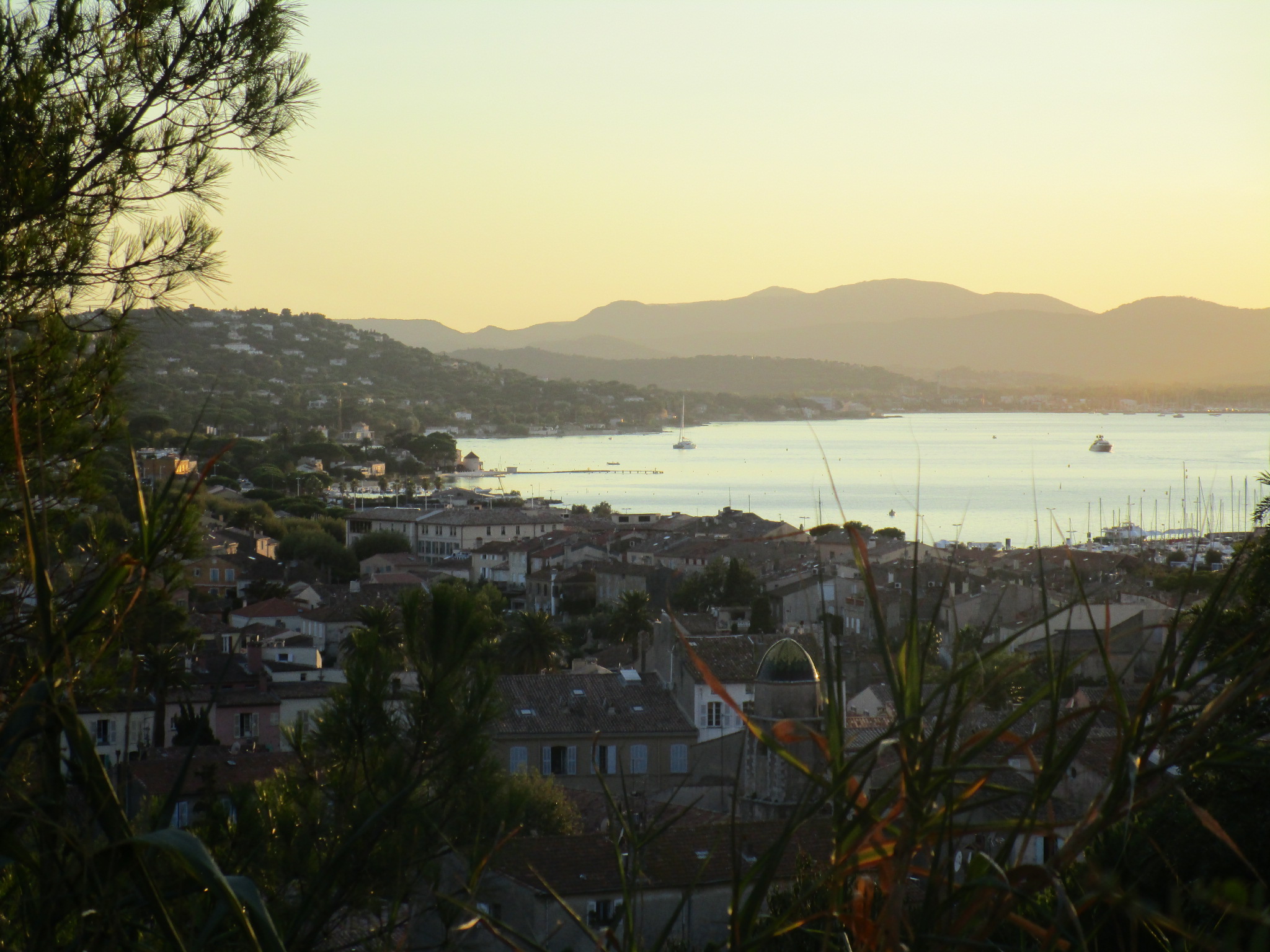 Hiked up to a hilltop to get a good view of Saint-Tropez
Hiked up to a hilltop to get a good view of Saint-Tropez Beauty shot of Andi and Nora during the golden hour.
Beauty shot of Andi and Nora during the golden hour.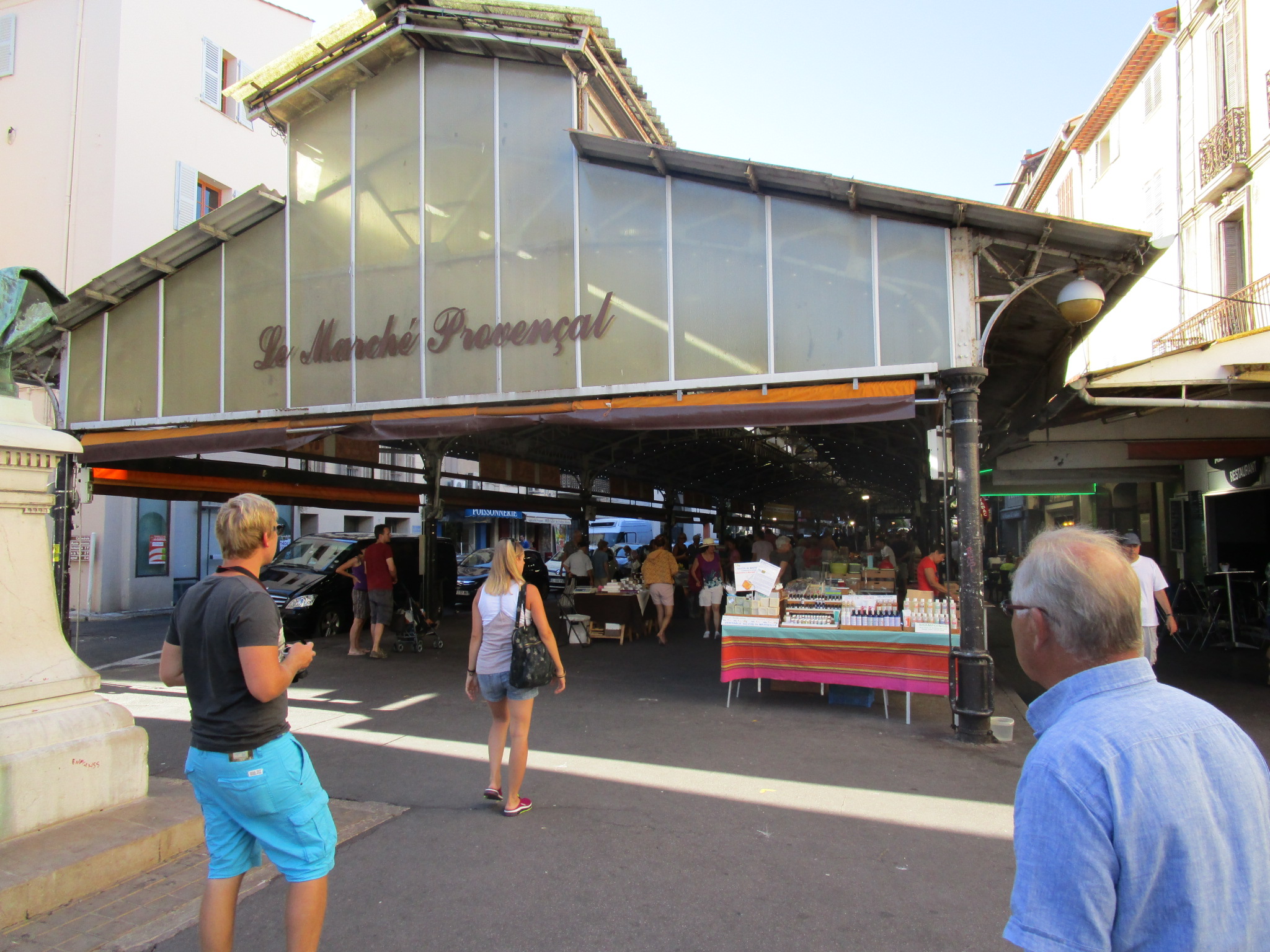 In the morning,we went back into town, within the old city walls, to do some more exploring and shopping. We found a Provencal street market where I was able to buy a big bag of the Camargue salt that Sharon loves to use for cooking. Actually, I bought a big bag and a small bag, so I could give her the small one and then surprise her with even more (ha ha, I’m a comedy genius).
In the morning,we went back into town, within the old city walls, to do some more exploring and shopping. We found a Provencal street market where I was able to buy a big bag of the Camargue salt that Sharon loves to use for cooking. Actually, I bought a big bag and a small bag, so I could give her the small one and then surprise her with even more (ha ha, I’m a comedy genius). You can barely make out our party, having a late breakfast, dead center in this photo.
You can barely make out our party, having a late breakfast, dead center in this photo. We climbed up and down all over the old town. Note here the swimmers in the water near the rocks.
We climbed up and down all over the old town. Note here the swimmers in the water near the rocks.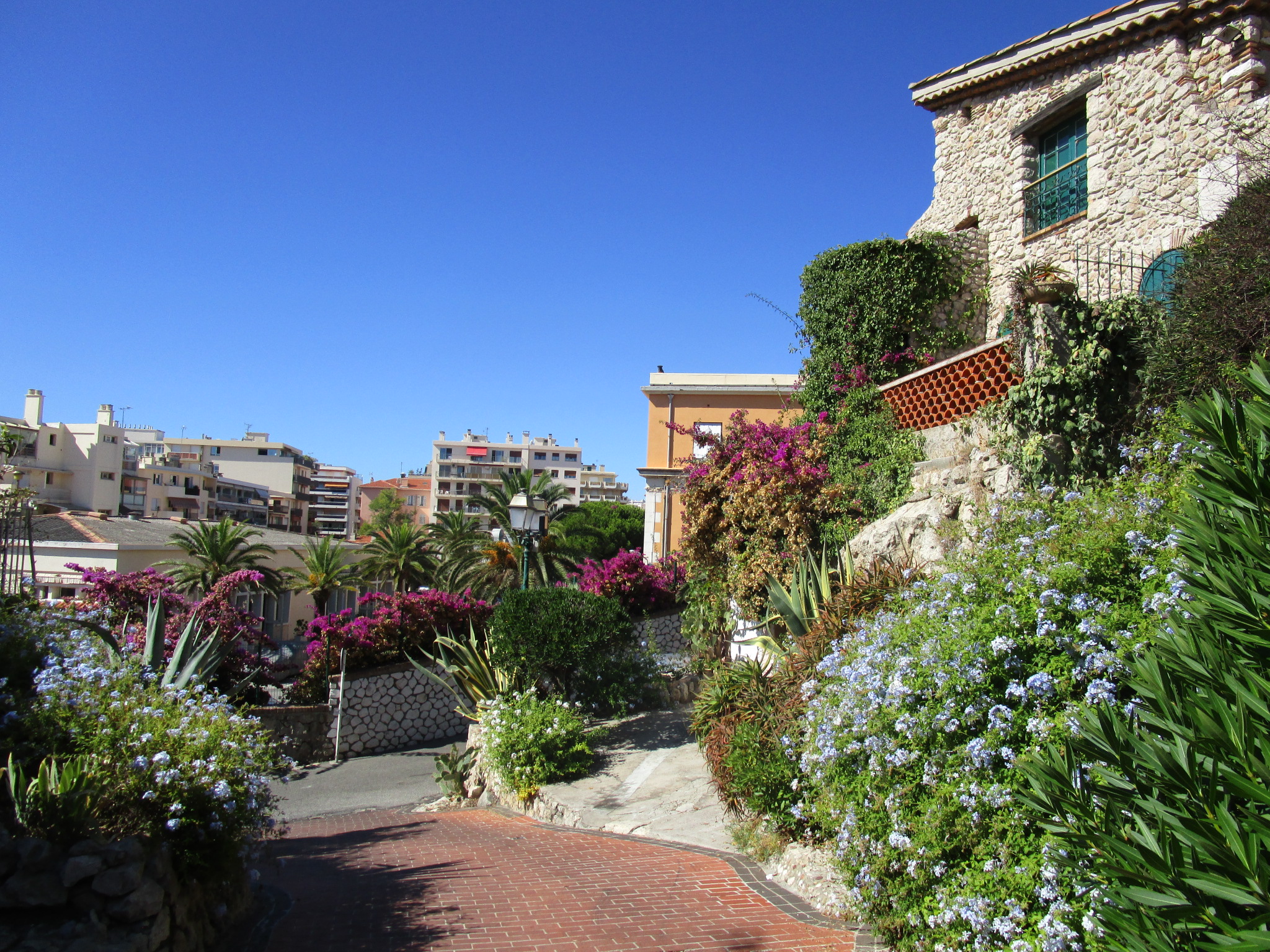 Just a random street scene from a residential neighborhood.
Just a random street scene from a residential neighborhood. Mandatory addition to the collection of cats spotted on vacation trips.
Mandatory addition to the collection of cats spotted on vacation trips. Finally we made our way back out through the old city walls and to the marina.
Finally we made our way back out through the old city walls and to the marina.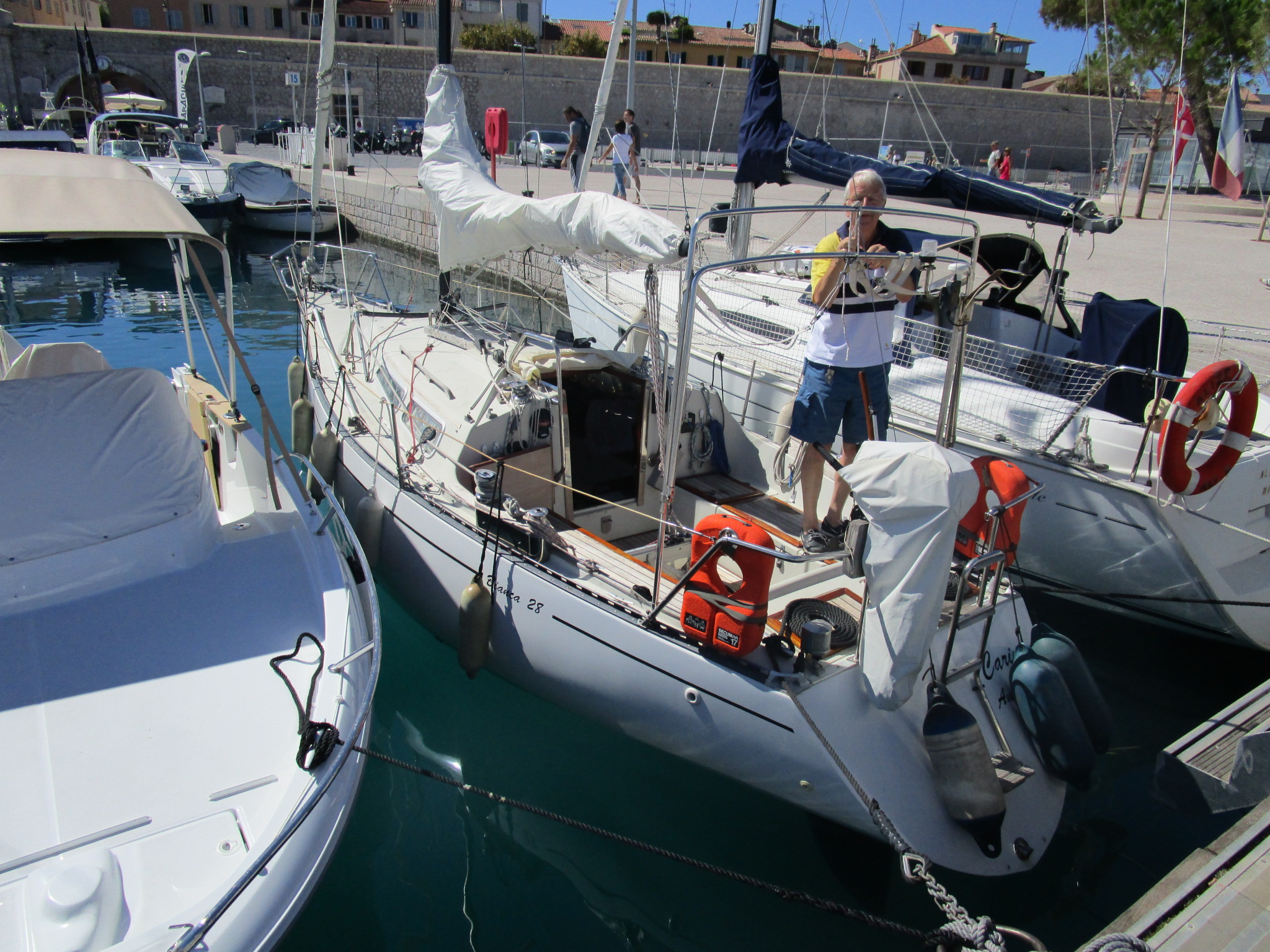 Gerhard showed us his smaller sailboat, recently outfitted with a new interior. Cozy!
Gerhard showed us his smaller sailboat, recently outfitted with a new interior. Cozy! From there, I went out on my own and visited the old fortress that looked over the harbor.
From there, I went out on my own and visited the old fortress that looked over the harbor.
 Finally after lunchtime we set sail again, passing the oil baron yachts again on the way out. Antibes was as far east as we would sail along the French coast. The next stop would have been Nice, which is a practically a metropolis (and which I’d visited briefly as a teenager). Monaco was beyond that. They are all fabulously glamorous destinations, I’m sure, but probably a bit of a pain to deal with in a little sailboat, and a stretch for us if we wanted to get back to Marseilles in time for my train out, and so we were now going to head back to the west.
Finally after lunchtime we set sail again, passing the oil baron yachts again on the way out. Antibes was as far east as we would sail along the French coast. The next stop would have been Nice, which is a practically a metropolis (and which I’d visited briefly as a teenager). Monaco was beyond that. They are all fabulously glamorous destinations, I’m sure, but probably a bit of a pain to deal with in a little sailboat, and a stretch for us if we wanted to get back to Marseilles in time for my train out, and so we were now going to head back to the west.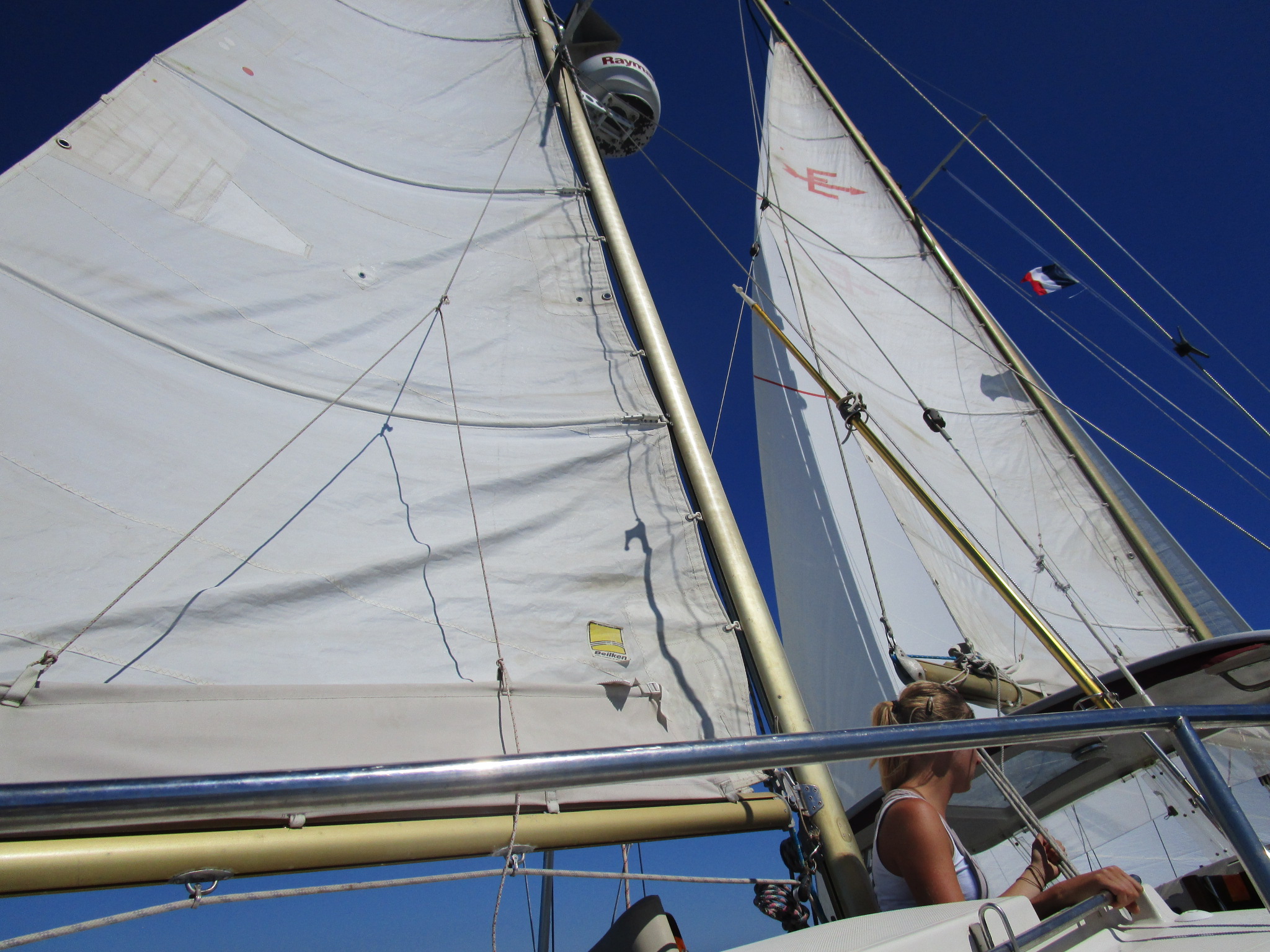 We put up the sails and made good time, which was a good thing because we had a pretty long way to go to make it to Andreas’ desired stop for the evening.
We put up the sails and made good time, which was a good thing because we had a pretty long way to go to make it to Andreas’ desired stop for the evening. Along the way, a French destroyer passed us.
Along the way, a French destroyer passed us.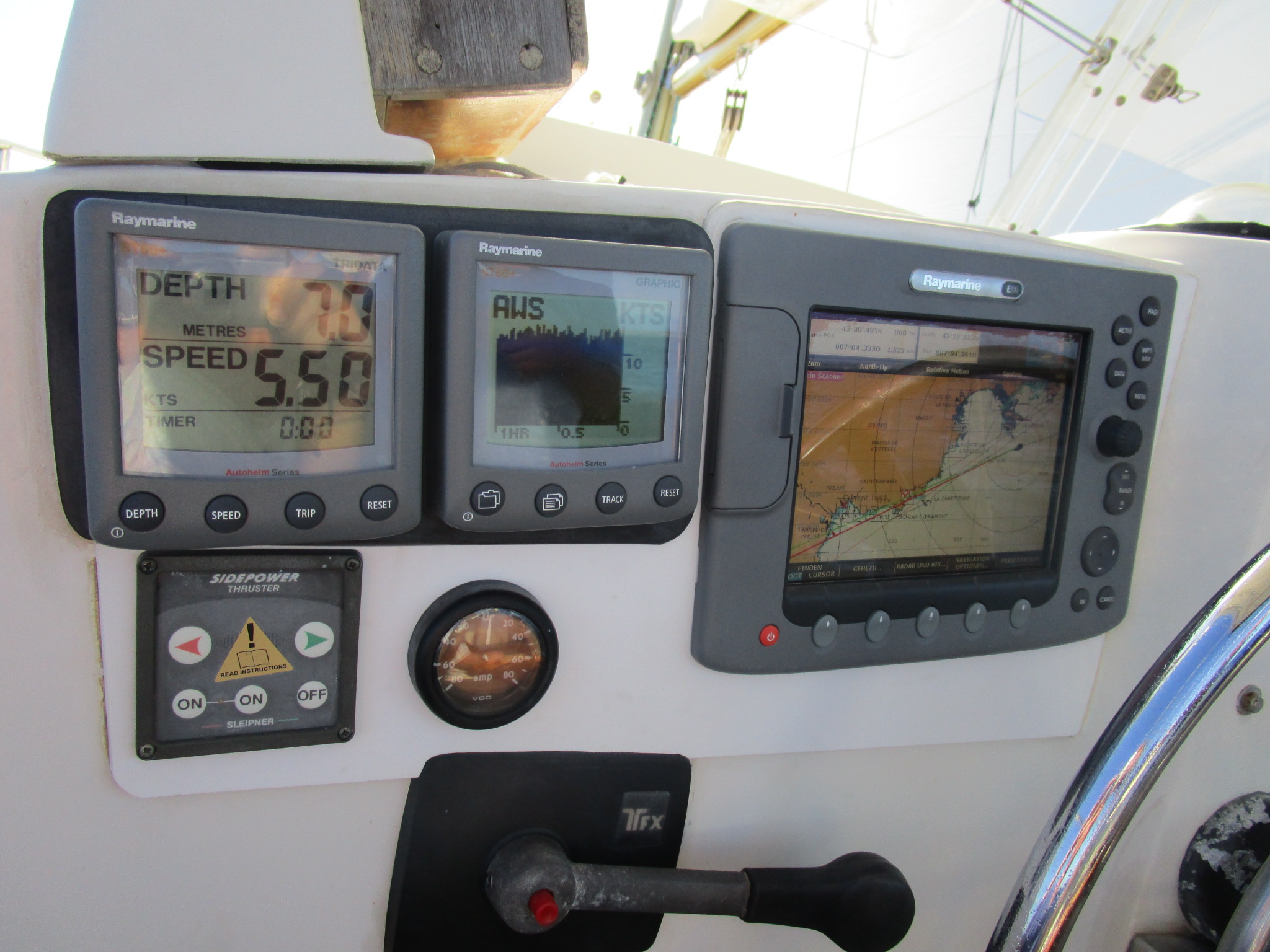 Here’s a view of the instrumentation at the captain’s position. The map display at right shows (with a small red X) our intended destination for the day. The black lever at bottom is the engine control, shown here set to neutral / off.
Here’s a view of the instrumentation at the captain’s position. The map display at right shows (with a small red X) our intended destination for the day. The black lever at bottom is the engine control, shown here set to neutral / off.
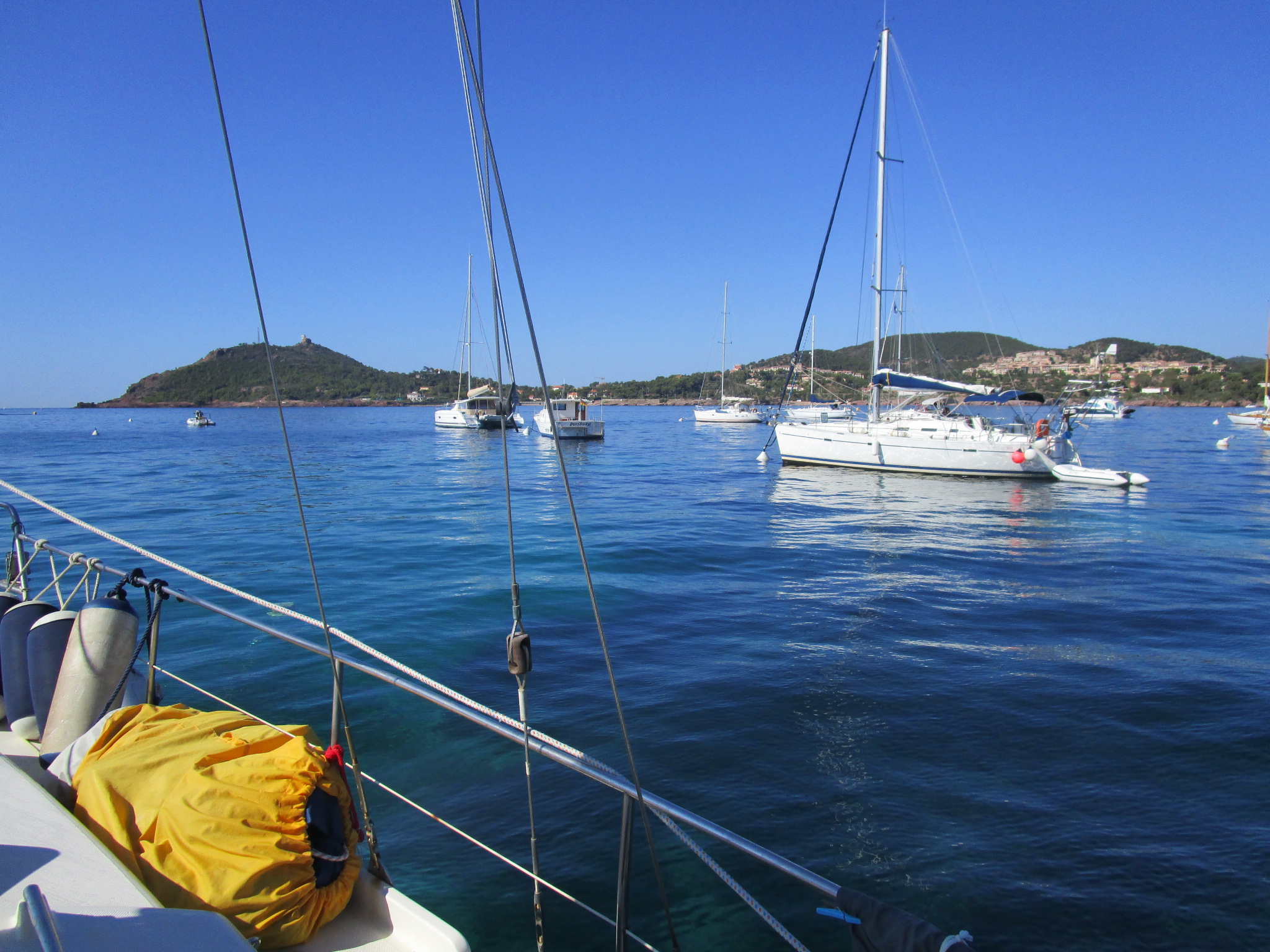 After a long afternoon of sailing, we arrived in the
After a long afternoon of sailing, we arrived in the 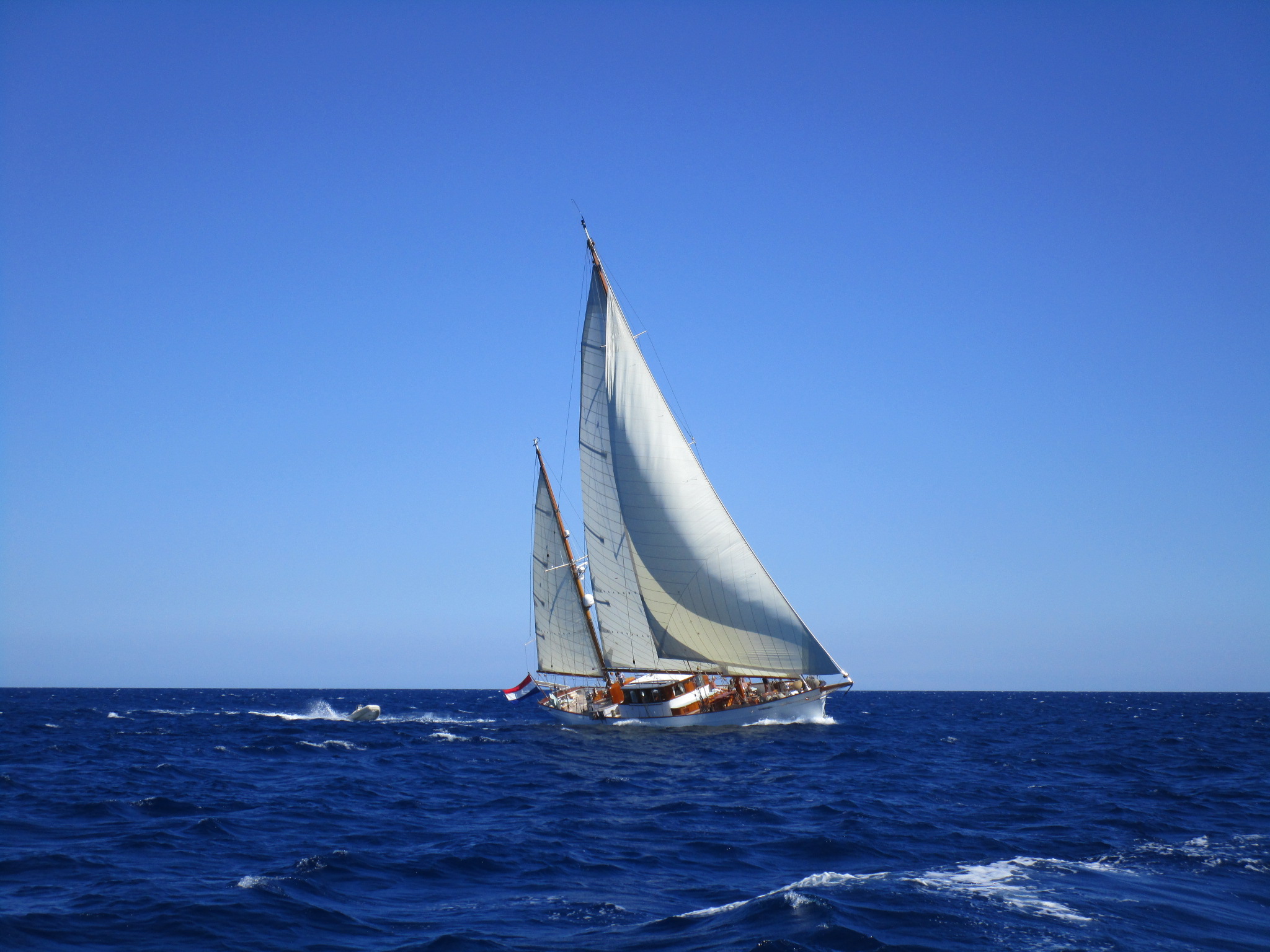 In the morning, Andreas’ friend Wolfgang arrived in Frejus by train and joined us on the sailboat. So now we were five.
In the morning, Andreas’ friend Wolfgang arrived in Frejus by train and joined us on the sailboat. So now we were five. Wolfgang had a video camera and was videoing a lot, which I found annoying at the time, but for which I am now thankful, because it documented where we went for the rest of the trip. I had kept notes about where we had gone and what we did up to this point, which resulted in the blog posts that preceded this one, but I fell behind starting with this leg of the trip. Wolfgang’s videos (which he provided to us later) were crucial in helping me remember the details, and I thank him for running that annoying camera!
Wolfgang had a video camera and was videoing a lot, which I found annoying at the time, but for which I am now thankful, because it documented where we went for the rest of the trip. I had kept notes about where we had gone and what we did up to this point, which resulted in the blog posts that preceded this one, but I fell behind starting with this leg of the trip. Wolfgang’s videos (which he provided to us later) were crucial in helping me remember the details, and I thank him for running that annoying camera!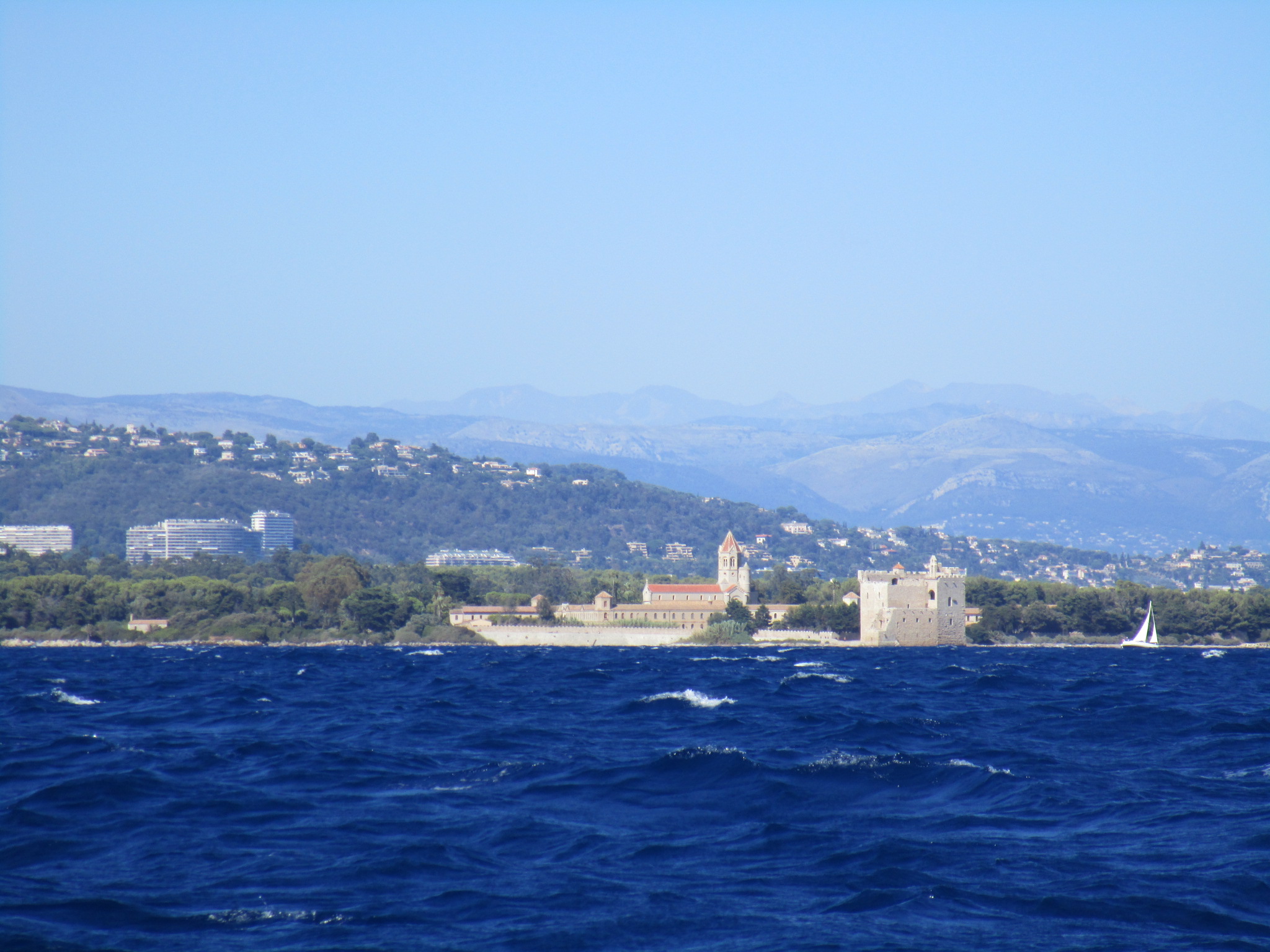 We sailed out of Frejus and headed towards Antibes.
We sailed out of Frejus and headed towards Antibes.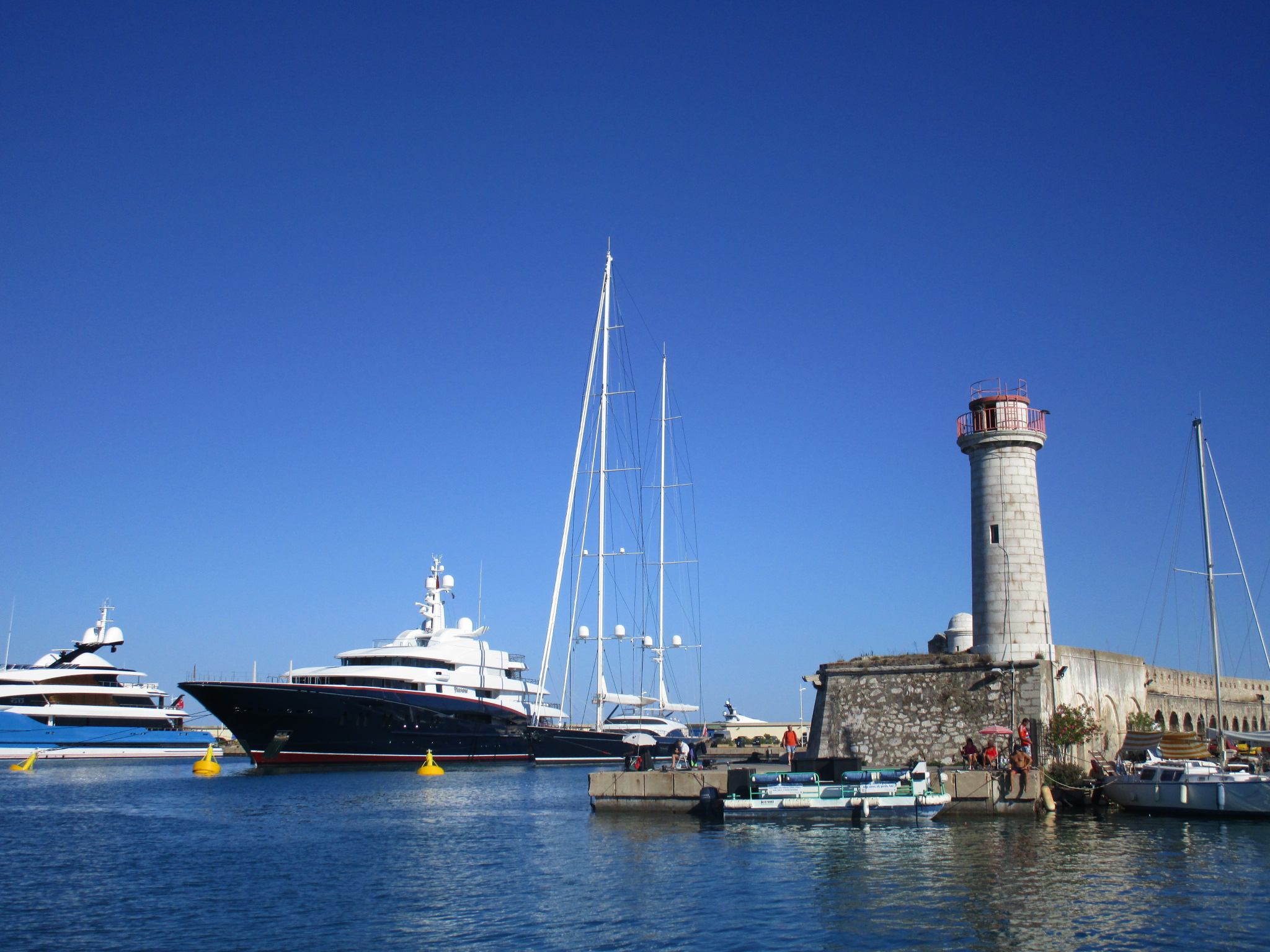 Antibes is a historic destination on the French Mediterranean coast. I suppose that if you approached on land, you’d be driving through the amazing Provencal landscapes. But entering via the harbor, your introduction to the town is the massive yachts of the Middle Eastern oil barons — yachts that are the size of small military ships. They have to get moored at the outer edge of the harbor, since they are far too big to navigate closer in. They are typically fully staffed at all times, kept cleaned and stocked with supplies, and ready at any time to depart if the owner decides he wants to move on. That is, if the owner is even in Antibes …
Antibes is a historic destination on the French Mediterranean coast. I suppose that if you approached on land, you’d be driving through the amazing Provencal landscapes. But entering via the harbor, your introduction to the town is the massive yachts of the Middle Eastern oil barons — yachts that are the size of small military ships. They have to get moored at the outer edge of the harbor, since they are far too big to navigate closer in. They are typically fully staffed at all times, kept cleaned and stocked with supplies, and ready at any time to depart if the owner decides he wants to move on. That is, if the owner is even in Antibes … Even among the regular motorboats, we looked modest. But this sailboat is a serious machine, built for the open ocean.
Even among the regular motorboats, we looked modest. But this sailboat is a serious machine, built for the open ocean. 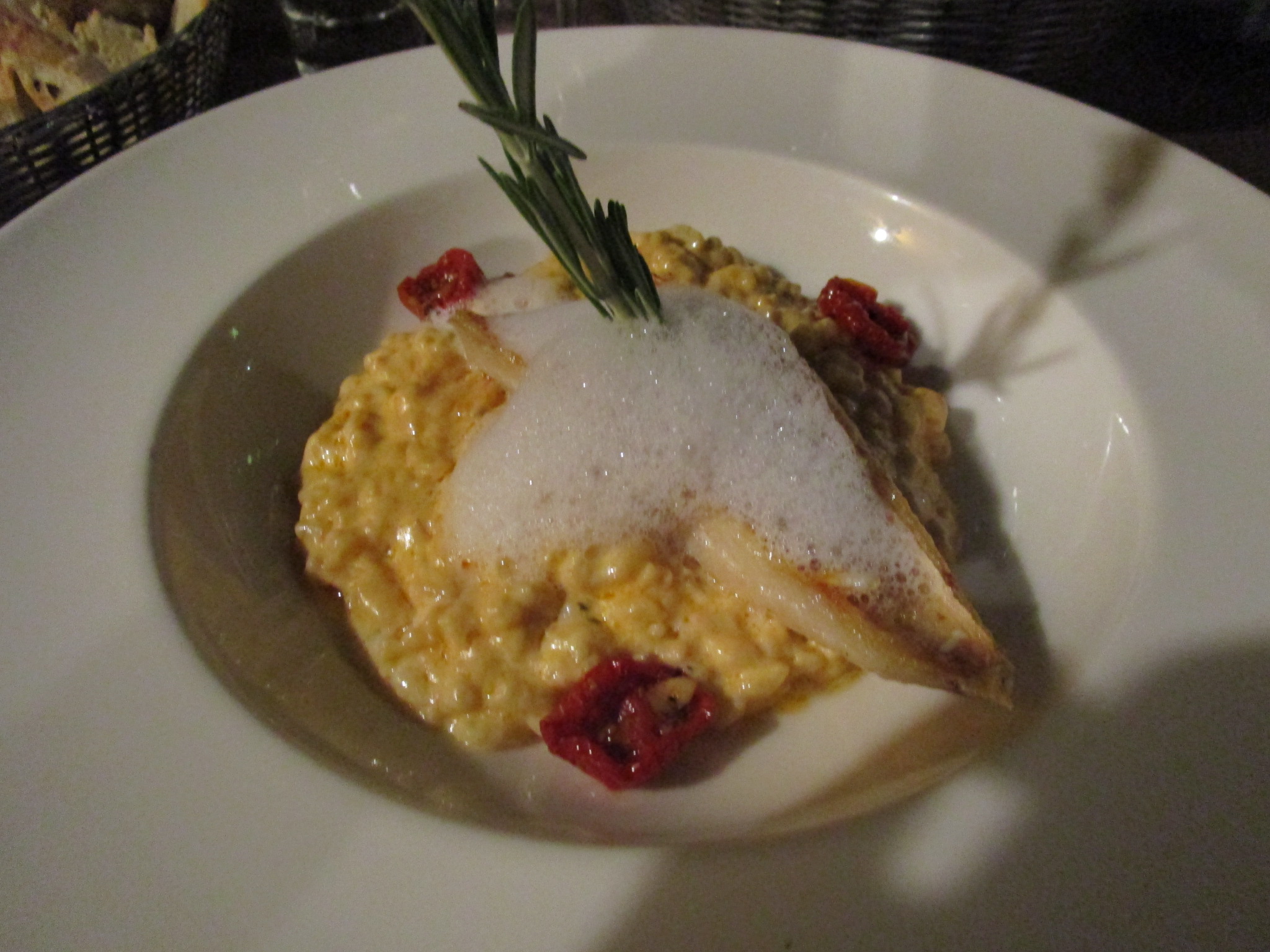 Andreas has an old friend who had retired to Antibes, and he brought us into the old city and took us out to dinner, a true fine dining experience that was representative of the local cuisine. It really was one of the most beautiful towns I’ve ever seen, and I hope someday to return with Sharon.
Andreas has an old friend who had retired to Antibes, and he brought us into the old city and took us out to dinner, a true fine dining experience that was representative of the local cuisine. It really was one of the most beautiful towns I’ve ever seen, and I hope someday to return with Sharon.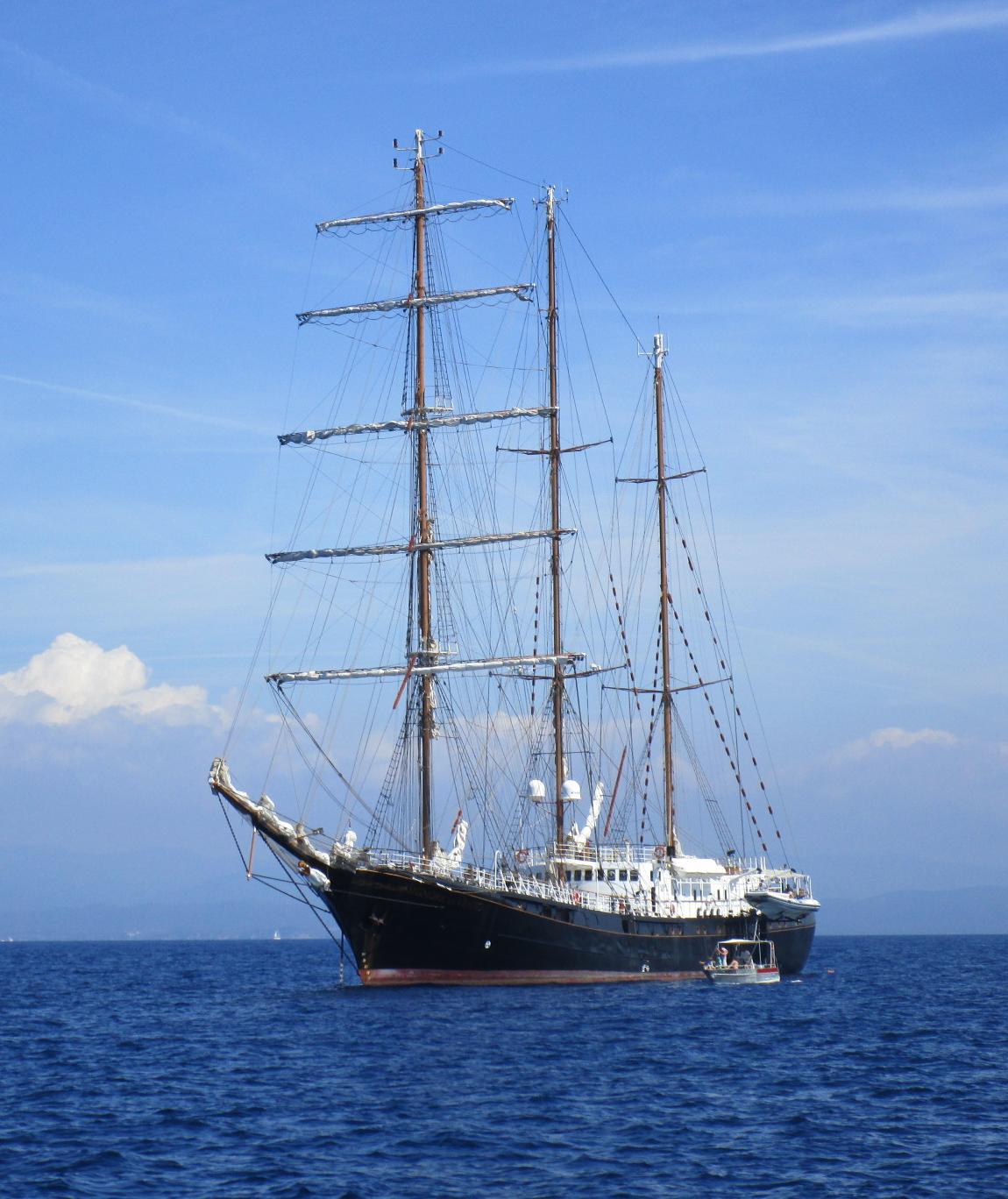 Porquerolles was a nice town: good shower facilities (once you figured out the coin-op system), nice restaurants, a grocery store, scenic location, everything. We’d be back later.
Porquerolles was a nice town: good shower facilities (once you figured out the coin-op system), nice restaurants, a grocery store, scenic location, everything. We’d be back later.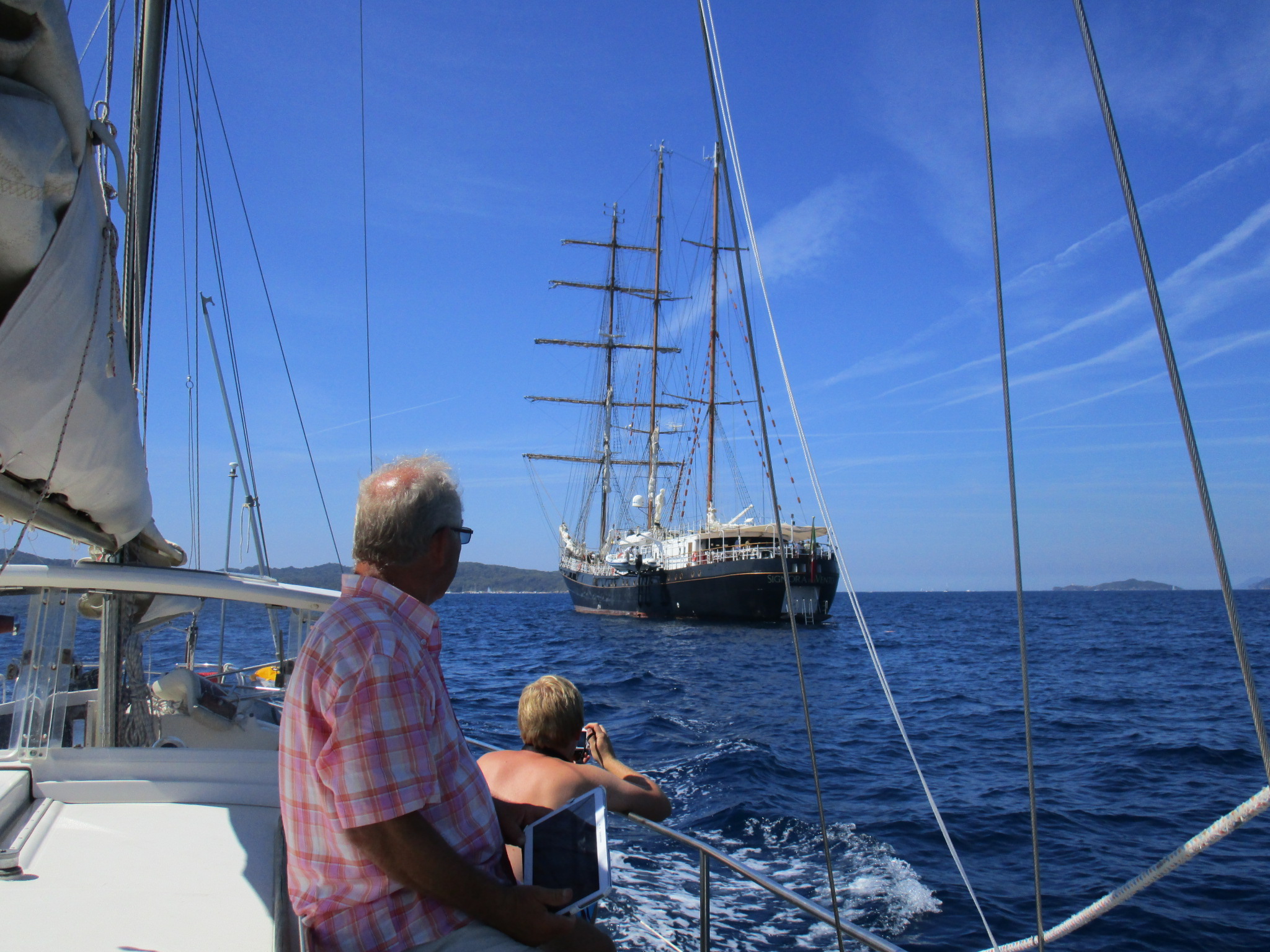 After a slow morning we finally pulled in our ropes and set forth out of the Porquerolles harbor. Immediately we spotted a huge three-masted sailing ship heading towards us. It was named the
After a slow morning we finally pulled in our ropes and set forth out of the Porquerolles harbor. Immediately we spotted a huge three-masted sailing ship heading towards us. It was named the 
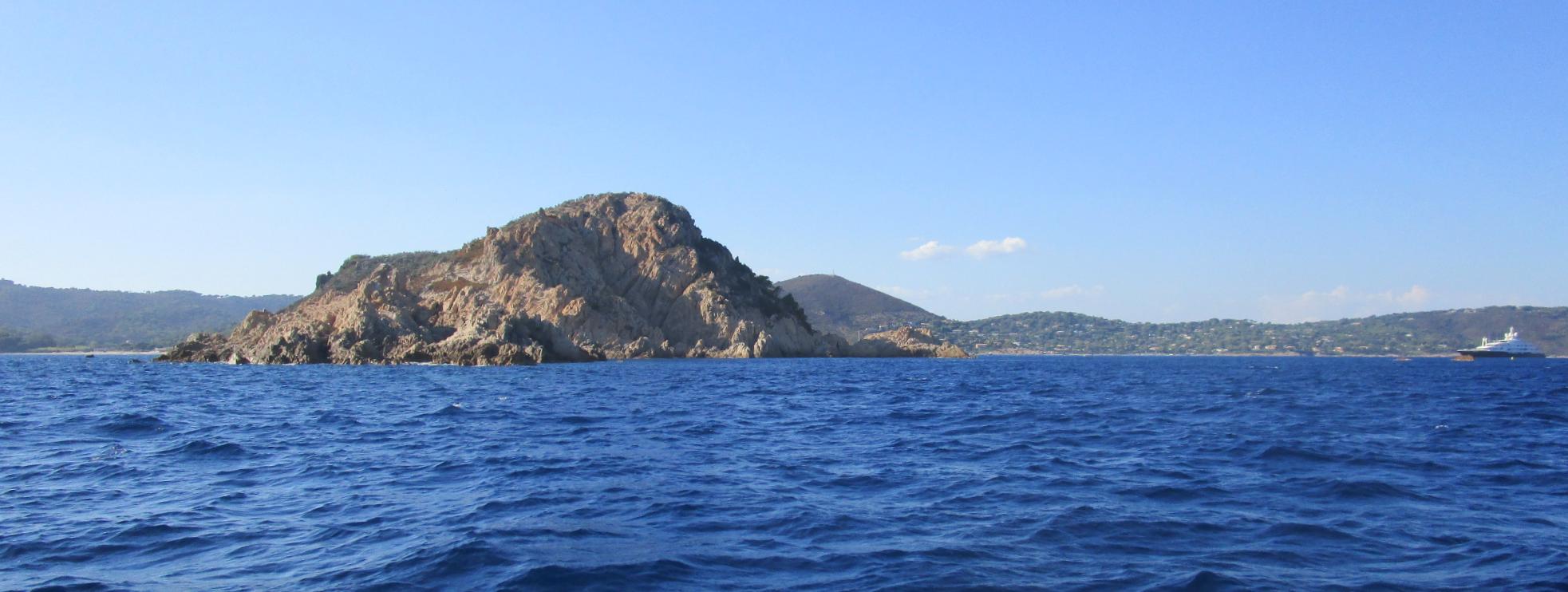
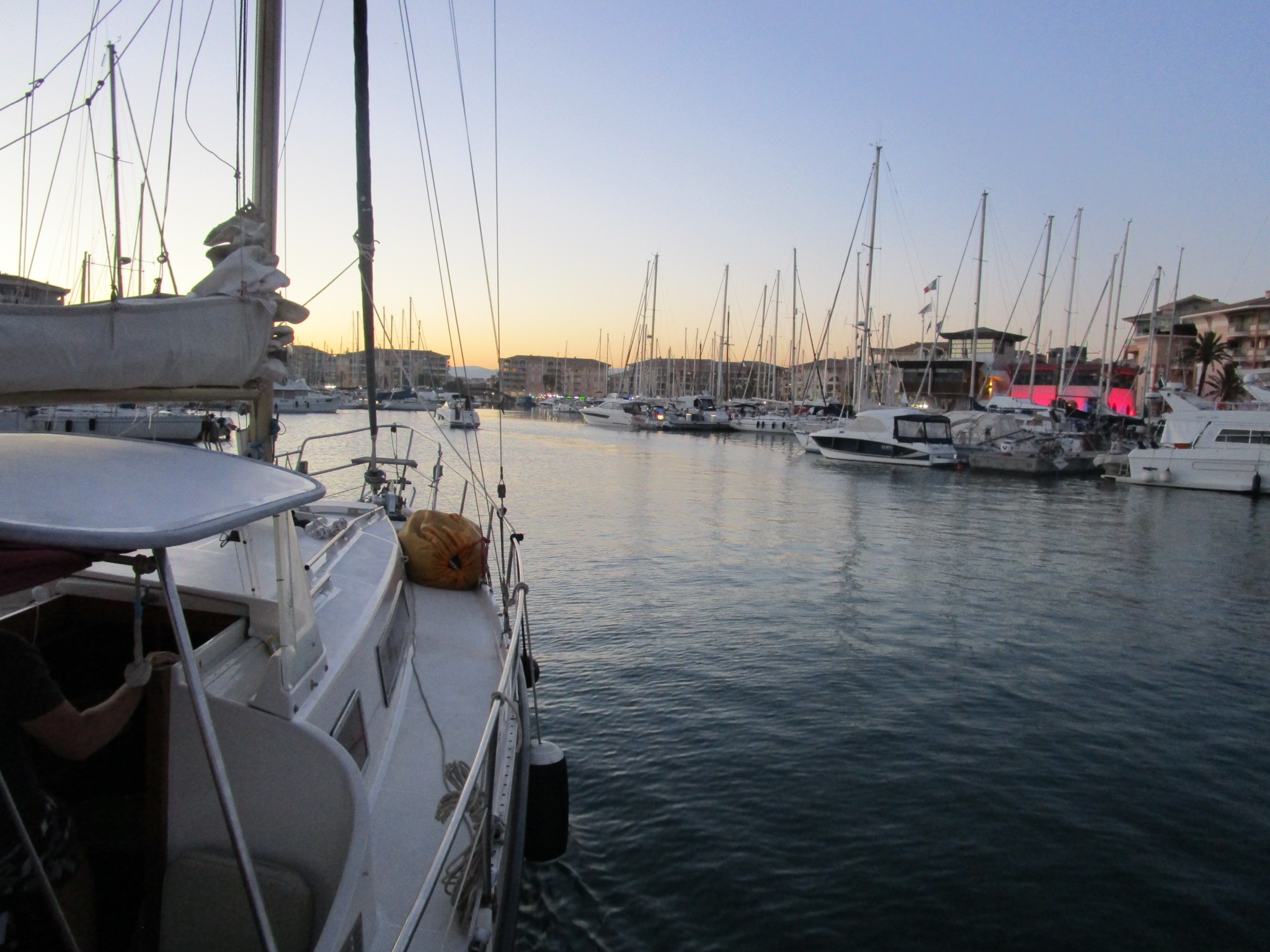
 Second day of sailing! I rose at dawn and cleaned up in the marina shower. Going into this trip, one of the unknowns for me was whether we’d be on the water around the clock, never showering, or stoppin at marinas occasionally, or what. I had no idea what I was in for, and was prepared to a slimy, smelly sailor for the full week. As it turned out, every night we’d sail into the marina of the nearest coastal town and dock the ship. All of these marinas have pay showers, so we stayed relatively clean. I say “relatively”, because after only a few hours in the sunshine on the open water, you are pretty nasty. The metamorphosis before and after shower was pretty remarkable, and lord knows I do love a long hot shower (ask my family, I’m notorious for it).
Second day of sailing! I rose at dawn and cleaned up in the marina shower. Going into this trip, one of the unknowns for me was whether we’d be on the water around the clock, never showering, or stoppin at marinas occasionally, or what. I had no idea what I was in for, and was prepared to a slimy, smelly sailor for the full week. As it turned out, every night we’d sail into the marina of the nearest coastal town and dock the ship. All of these marinas have pay showers, so we stayed relatively clean. I say “relatively”, because after only a few hours in the sunshine on the open water, you are pretty nasty. The metamorphosis before and after shower was pretty remarkable, and lord knows I do love a long hot shower (ask my family, I’m notorious for it). After shower, while Andreas et al were getting ready for departure, I hoofed down the marina to get a picture of this exotic old sailboat that was undergoing a restoration. All along the marina were these boats being worked on by contractors, and this one was obvious historic and a labor of love for someone. I’m sure the comically long boom off the front identifies the type of sailboat, but I don’t know what it is.
After shower, while Andreas et al were getting ready for departure, I hoofed down the marina to get a picture of this exotic old sailboat that was undergoing a restoration. All along the marina were these boats being worked on by contractors, and this one was obvious historic and a labor of love for someone. I’m sure the comically long boom off the front identifies the type of sailboat, but I don’t know what it is. As we headed into the open water, we started to encounter more serious traffic. Marseille is the main ferry transit point for this part of the Mediterranean, and there is constant activity with both small pleasure boats going in and out of the old city harbor and huge commercial crafts accessing the big industrial harbor. Many of these big ships are ferry boats heading to Sardinia and Algiers, carrying both tourist traffic and regular commercial traffic. You do not want to be surprised to see one of these bearing down on your tiny little sailboat.
As we headed into the open water, we started to encounter more serious traffic. Marseille is the main ferry transit point for this part of the Mediterranean, and there is constant activity with both small pleasure boats going in and out of the old city harbor and huge commercial crafts accessing the big industrial harbor. Many of these big ships are ferry boats heading to Sardinia and Algiers, carrying both tourist traffic and regular commercial traffic. You do not want to be surprised to see one of these bearing down on your tiny little sailboat. Finally, some sailing! Andreas, Andy and Nora got to unfurling the sails — I’d be helpful whereever I could, and whenever so ordered, but otherwise I stayed out of the way and watched them work. This type of sailboat (a ketch) has three sails, the big one in the middle of the boat called the mainsail, one at the front (bow) called a jib, and one at the back (stern) called a mizzen.
Finally, some sailing! Andreas, Andy and Nora got to unfurling the sails — I’d be helpful whereever I could, and whenever so ordered, but otherwise I stayed out of the way and watched them work. This type of sailboat (a ketch) has three sails, the big one in the middle of the boat called the mainsail, one at the front (bow) called a jib, and one at the back (stern) called a mizzen.  So when setting sail, you’ve got three different sails and booms to deal with, and so enough to keep three people very busy for a couple minutes. But the ropes (“sheets”) that raise and control those sails all come back to the cockpit, so in theory at least ONE person could do the whole thing. Not likely though.
So when setting sail, you’ve got three different sails and booms to deal with, and so enough to keep three people very busy for a couple minutes. But the ropes (“sheets”) that raise and control those sails all come back to the cockpit, so in theory at least ONE person could do the whole thing. Not likely though. We had great wind, at our backs actually, and in that case you can bust out the king of the sails, the
We had great wind, at our backs actually, and in that case you can bust out the king of the sails, the  Instead of both bottom corners flying free, held back only by ropes, in the gennaker one corner is held to the bow of the ship and the other corner is flying free. This way it’s off to one side of the boat, and actually catching slightly more wind than a spinnaker would, because you then sail with the wind slightly off your rear — the mainsail (in the middle of the boat) doesn’t “shadow” the gennaker and you get more total wind power driving the boat.
Instead of both bottom corners flying free, held back only by ropes, in the gennaker one corner is held to the bow of the ship and the other corner is flying free. This way it’s off to one side of the boat, and actually catching slightly more wind than a spinnaker would, because you then sail with the wind slightly off your rear — the mainsail (in the middle of the boat) doesn’t “shadow” the gennaker and you get more total wind power driving the boat.


 After about an hour of fast running with the sails set like this, suddenly we had to spring into action. One of the cleats had popped off the main mast and a sail went flying. Andreas said that it was not one of the original cleats, rather one that a local worker had added for him. Poor quality work, but we also had too much rope tied off on that one little cleat — there are bigger cleats designed to handle bigger loads. Anyway, that’s actually really dangerous, and certainly things got real exciting for a minute there.
After about an hour of fast running with the sails set like this, suddenly we had to spring into action. One of the cleats had popped off the main mast and a sail went flying. Andreas said that it was not one of the original cleats, rather one that a local worker had added for him. Poor quality work, but we also had too much rope tied off on that one little cleat — there are bigger cleats designed to handle bigger loads. Anyway, that’s actually really dangerous, and certainly things got real exciting for a minute there. Here’s a good view of the cockpit, the main seating area (I actually forget now what the right term is for it). It’s where the captain mans the controls, and where all the ropes end up. Close to us in this view is the red rope going around the port winch, a one-way ratcheting device that helps to pull the rope in and keep it tight. In this dual-gennaker configuration, Andreas decided to run the other rope (the green one) across the cabin — that’s not normal, but what we improvised that day. Then at the rear of the cabin (to the right in this picture) you see the main mast with quite a few ropes cleated off there.
Here’s a good view of the cockpit, the main seating area (I actually forget now what the right term is for it). It’s where the captain mans the controls, and where all the ropes end up. Close to us in this view is the red rope going around the port winch, a one-way ratcheting device that helps to pull the rope in and keep it tight. In this dual-gennaker configuration, Andreas decided to run the other rope (the green one) across the cabin — that’s not normal, but what we improvised that day. Then at the rear of the cabin (to the right in this picture) you see the main mast with quite a few ropes cleated off there.
 Now finally Andreas would get a look at the transmission. As I wrote earlier, this was a brand new engine, mated to the old transmission. I had already heard about how matching those up had caused some drama in the past year as they were doing the engine upgrade. But while we had been on the water today, in particular while maneuvering in close quarters in the harbors, Andreas became concerned about strange sounds that were coming from the transmission when the thing was put into reverse. So we popped the lid off the engine compartment, Andreas got down in there to take a look, and generally grumbled about the situation.
Now finally Andreas would get a look at the transmission. As I wrote earlier, this was a brand new engine, mated to the old transmission. I had already heard about how matching those up had caused some drama in the past year as they were doing the engine upgrade. But while we had been on the water today, in particular while maneuvering in close quarters in the harbors, Andreas became concerned about strange sounds that were coming from the transmission when the thing was put into reverse. So we popped the lid off the engine compartment, Andreas got down in there to take a look, and generally grumbled about the situation. I have been planning this sailing trip for about two years. Two summers ago, Andreas went on two-month trip around the Mediterranean, and was joined by friends and family at various times during the trip. I heard about this and declared my intent to join him someday, and we quickly made plans to target this summer for the trip.
I have been planning this sailing trip for about two years. Two summers ago, Andreas went on two-month trip around the Mediterranean, and was joined by friends and family at various times during the trip. I heard about this and declared my intent to join him someday, and we quickly made plans to target this summer for the trip. So here I am, on a sailboat at dawn, heading out into the Mediterranean Sea. Besides Andreas and me, also on board are my cousin Andy and his girlfriend Nora. Andy (Andreas’ son) has lots of experience sailing as well, and so between the two of them we’d always have someone at the helm who knew what they were doing. The rest of us were “crew”, meaning it was our job to make sail adjustments per the captain’s orders. Most of the time, we would just be executing a simple turn (usually a “tack” into the wind), which is just about the most basic sailing maneuver there is, so in theory we all knew what we had to do.
So here I am, on a sailboat at dawn, heading out into the Mediterranean Sea. Besides Andreas and me, also on board are my cousin Andy and his girlfriend Nora. Andy (Andreas’ son) has lots of experience sailing as well, and so between the two of them we’d always have someone at the helm who knew what they were doing. The rest of us were “crew”, meaning it was our job to make sail adjustments per the captain’s orders. Most of the time, we would just be executing a simple turn (usually a “tack” into the wind), which is just about the most basic sailing maneuver there is, so in theory we all knew what we had to do. The tentative plan, shown to the right, is to disembark from our home port (Port Camargue) and spend eight days working our way around towards Corsica and back. At the end of the sailing voyage (or at least my part of it) we will arrive in Marseille, where I will catch a train back to Paris, straight to the airport and back to Atlanta.
The tentative plan, shown to the right, is to disembark from our home port (Port Camargue) and spend eight days working our way around towards Corsica and back. At the end of the sailing voyage (or at least my part of it) we will arrive in Marseille, where I will catch a train back to Paris, straight to the airport and back to Atlanta.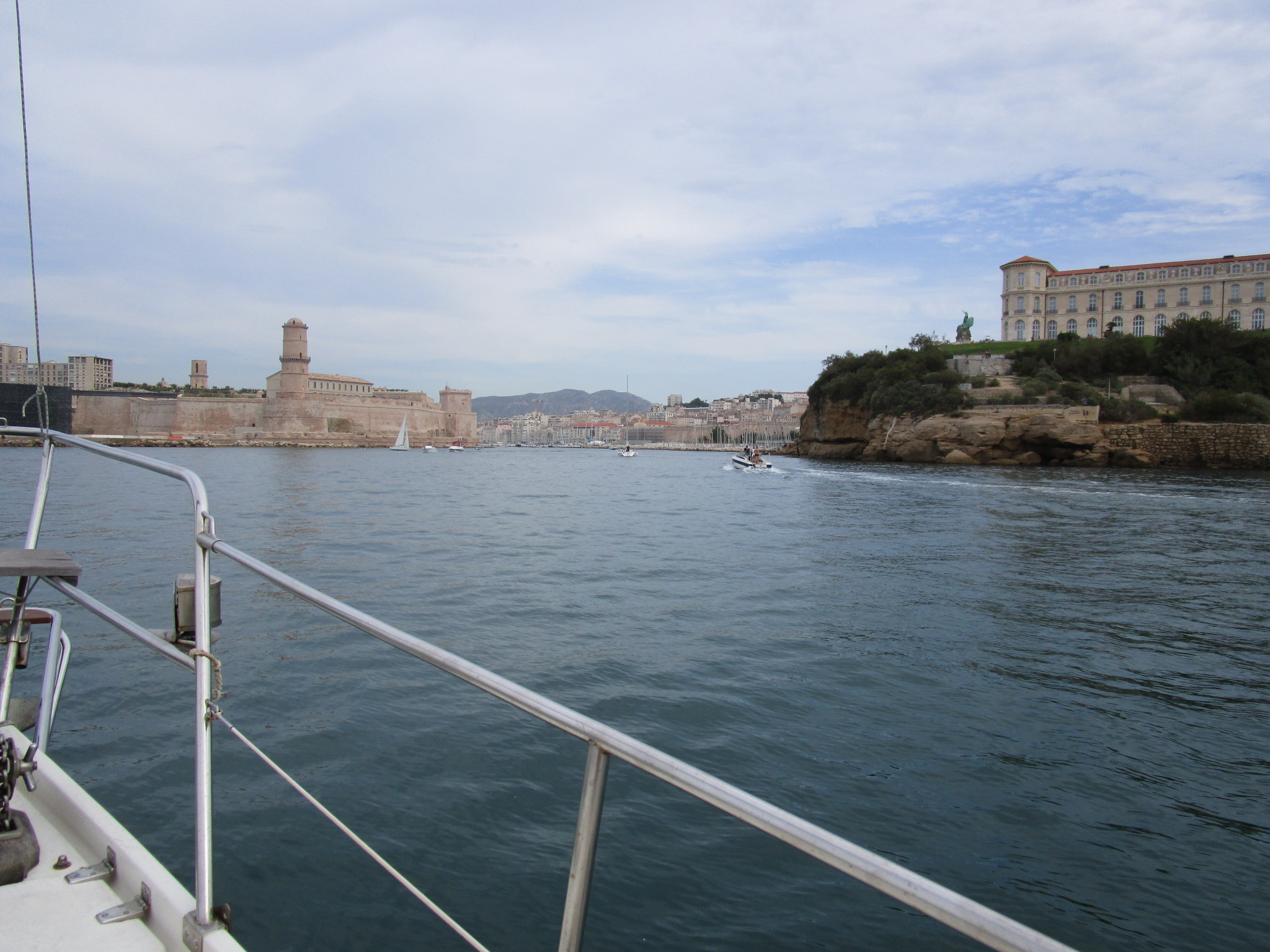 So we went back to motoring. Which Andreas was happy to do, since this was the first time he got to see his new engine in operation. The sailboat had been in drydock for over a year (maybe two) to get the engine replaced, and it now had a brand new
So we went back to motoring. Which Andreas was happy to do, since this was the first time he got to see his new engine in operation. The sailboat had been in drydock for over a year (maybe two) to get the engine replaced, and it now had a brand new 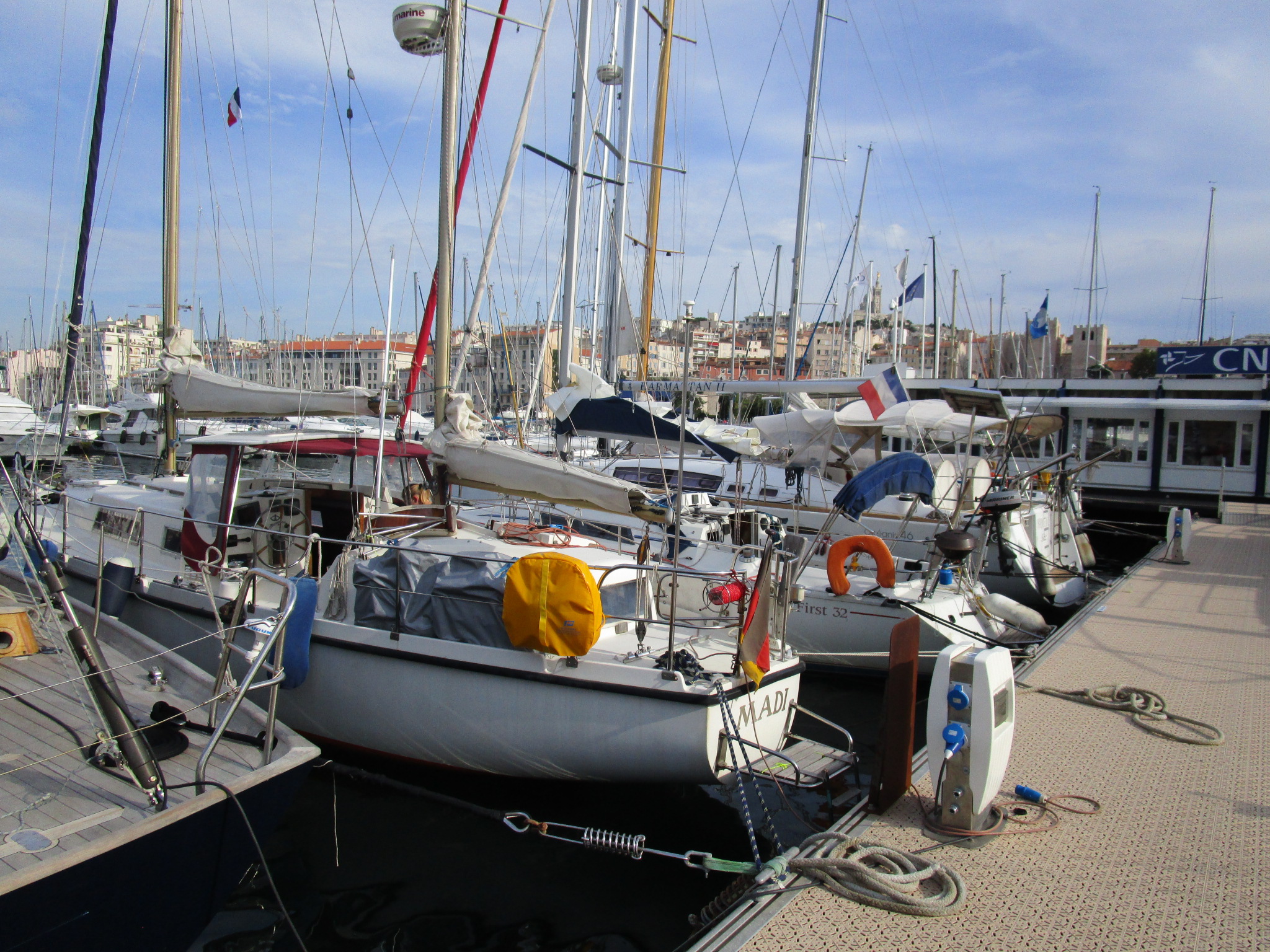 After a whole day of sailing (driving, really), we approached the busy harbor of Marseille. The old harbor in the city center was utterly jammed with a variety of pleasure boats, both sailboats and motor yachts, and it took us a while to find our berth.
After a whole day of sailing (driving, really), we approached the busy harbor of Marseille. The old harbor in the city center was utterly jammed with a variety of pleasure boats, both sailboats and motor yachts, and it took us a while to find our berth. Packed up and headed to the train station! Well, first to just leave my bags in a locker and do a little more sightseeing, as the train wouldn’t be leaving until the afternoon. After dropping off the load, I wandered around the city center a bit, took a mouette across the lake again (to get from point A to point B, really!), saw an interesting outdoor exhibition about world poverty along the lake, and made my way to the science museum.
Packed up and headed to the train station! Well, first to just leave my bags in a locker and do a little more sightseeing, as the train wouldn’t be leaving until the afternoon. After dropping off the load, I wandered around the city center a bit, took a mouette across the lake again (to get from point A to point B, really!), saw an interesting outdoor exhibition about world poverty along the lake, and made my way to the science museum. Geneva’s science museum is actually a
Geneva’s science museum is actually a  Relaxed for a while on the lawn in front of the science museum, and then headed to the train station for my departure. Happily, there was a train that went direct from Geneva to Montpelier (France), which is where my uncle Andreas would be picking me up. I had booked all of the trains on this trip ahead of time, except for this one, because I originally wasn’t sure of when I’d get access to CERN and wanted to be flexible. So once the CERN situation was set up, I booked this train and was relieved that there was a direct connection and that there was space on it!
Relaxed for a while on the lawn in front of the science museum, and then headed to the train station for my departure. Happily, there was a train that went direct from Geneva to Montpelier (France), which is where my uncle Andreas would be picking me up. I had booked all of the trains on this trip ahead of time, except for this one, because I originally wasn’t sure of when I’d get access to CERN and wanted to be flexible. So once the CERN situation was set up, I booked this train and was relieved that there was a direct connection and that there was space on it!
